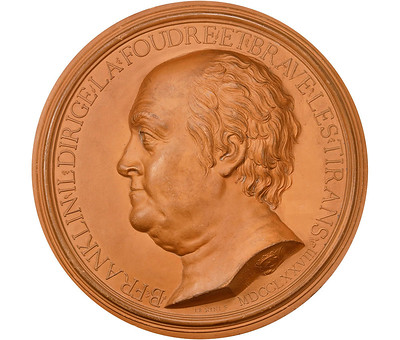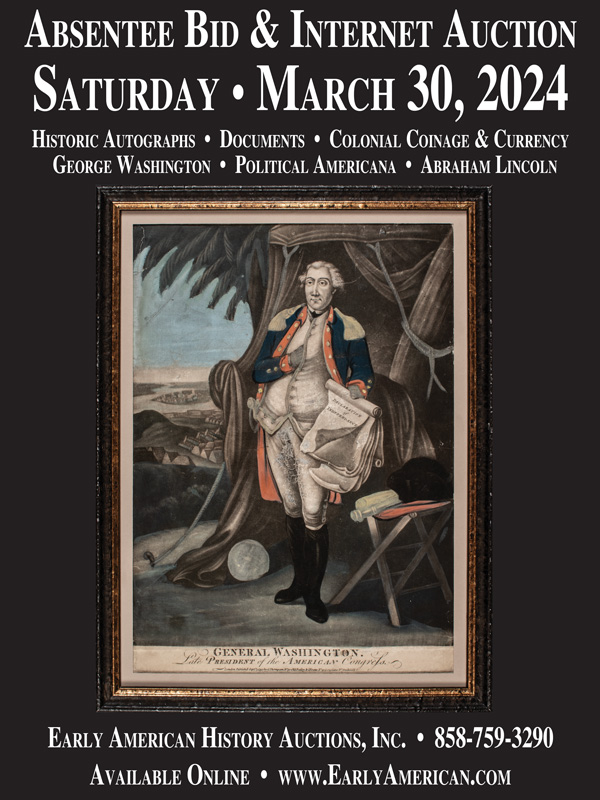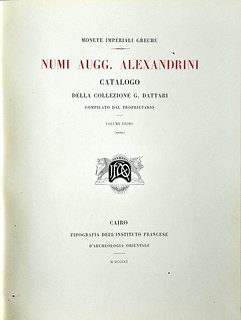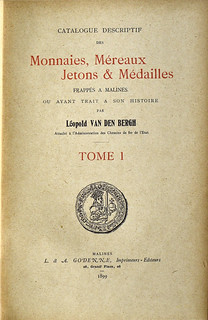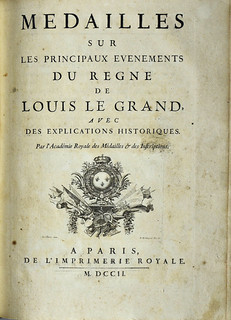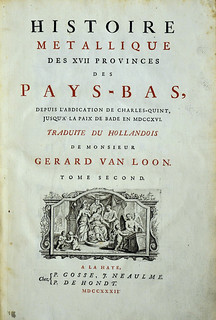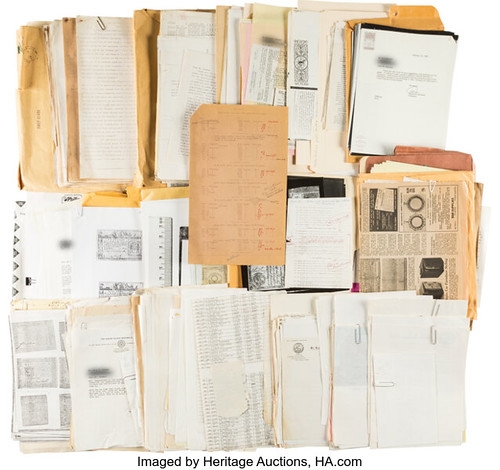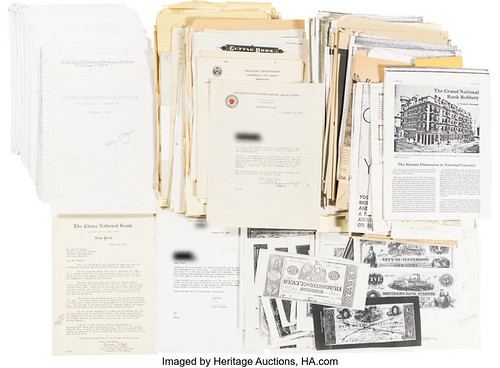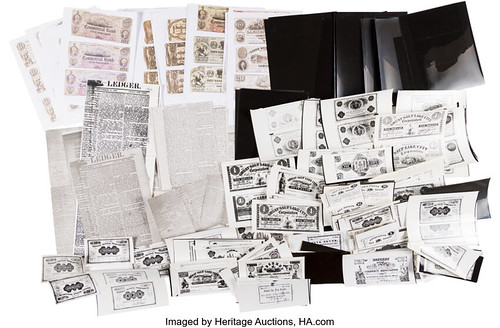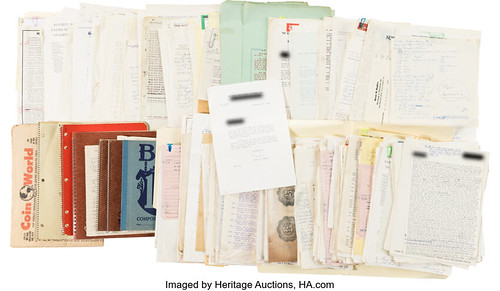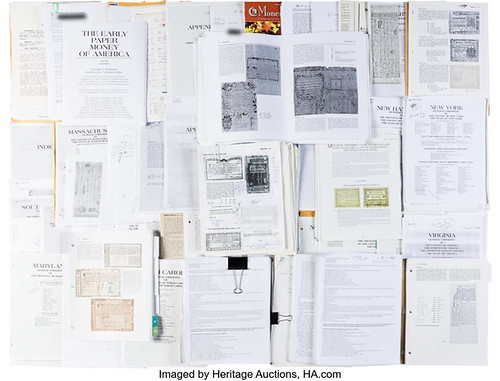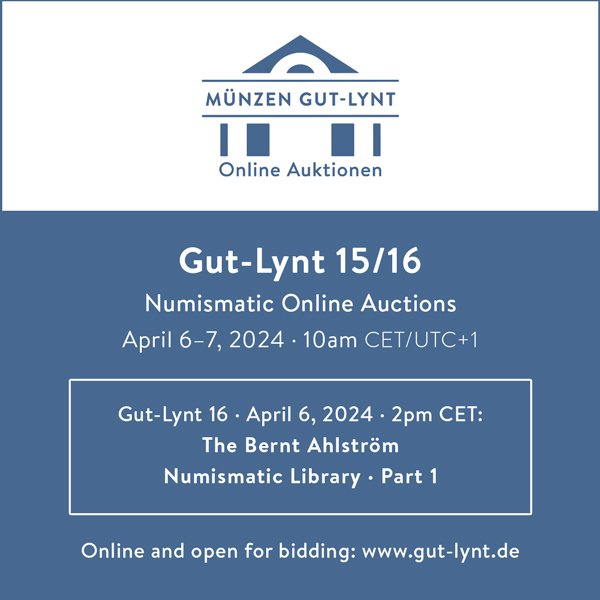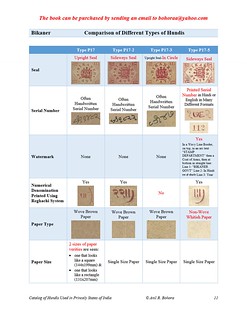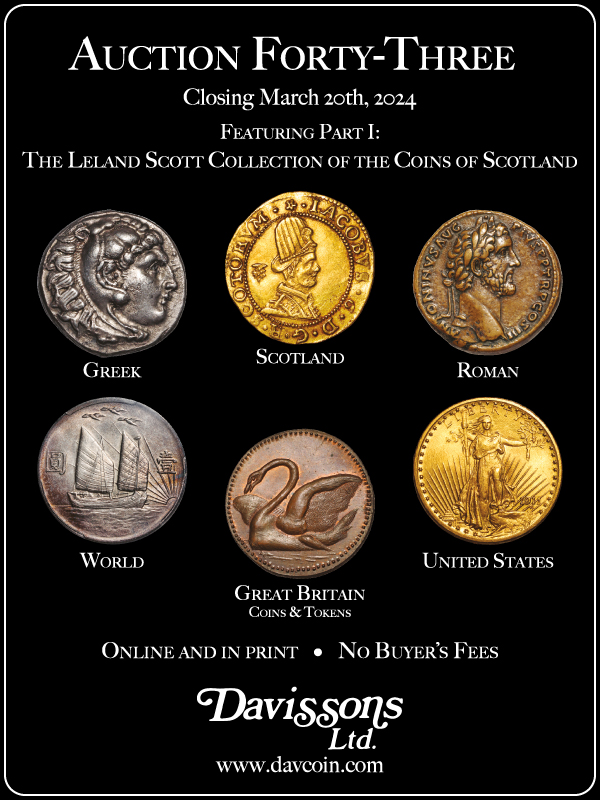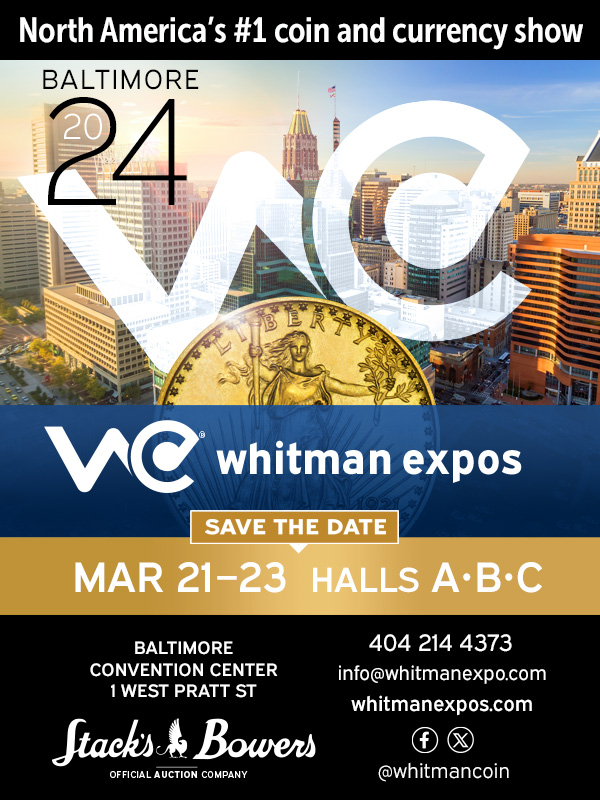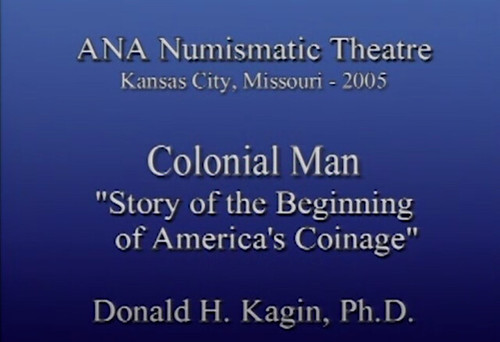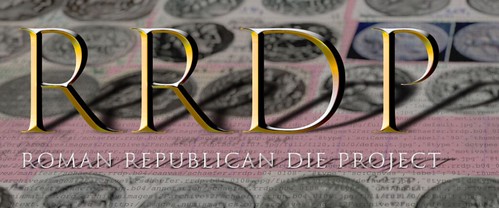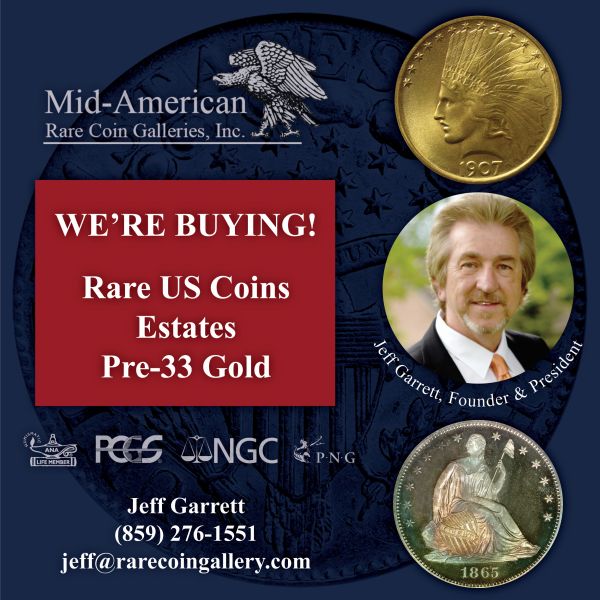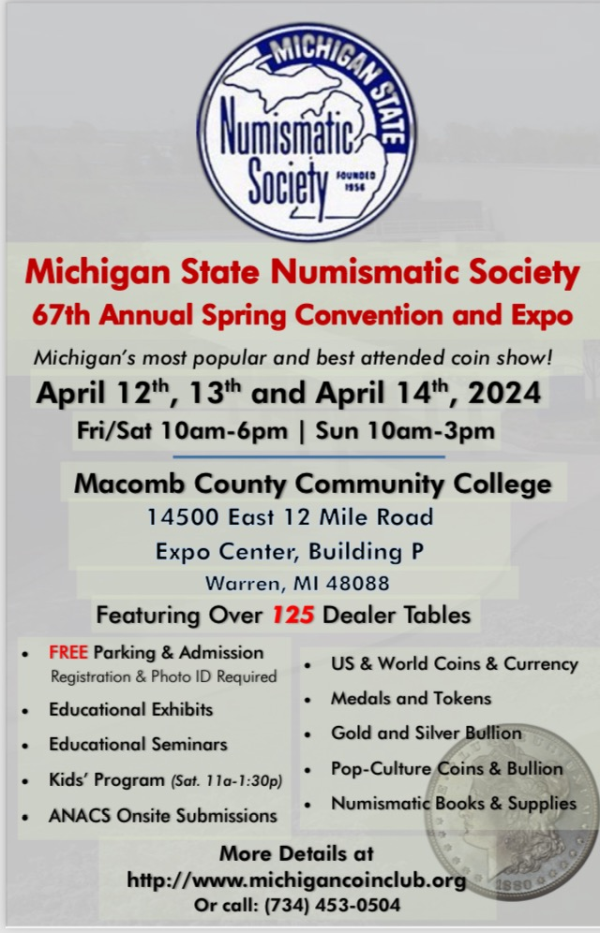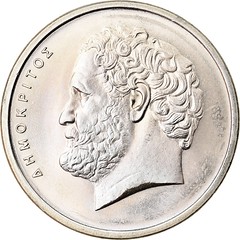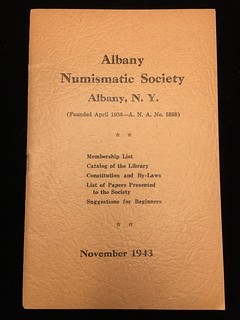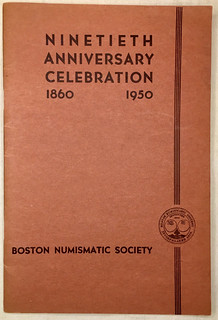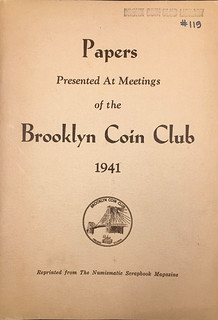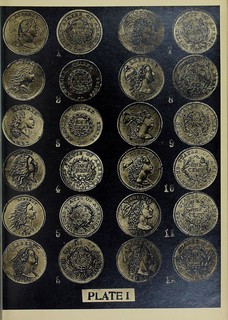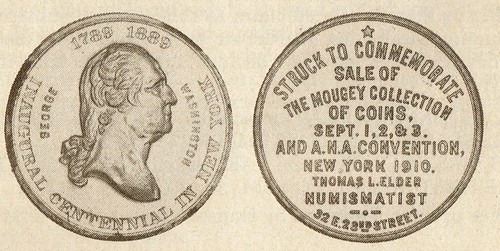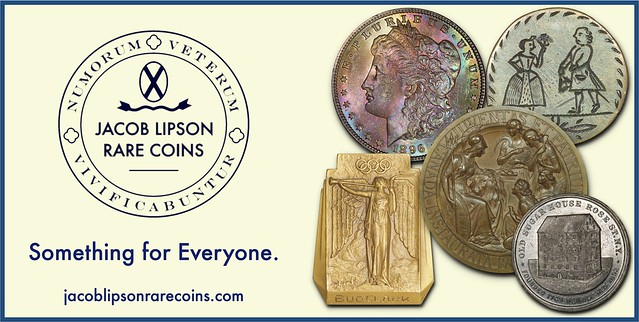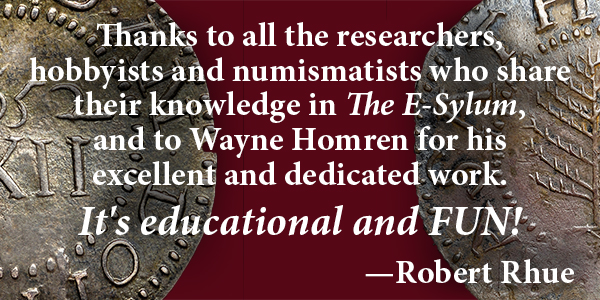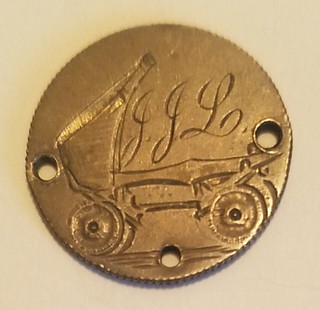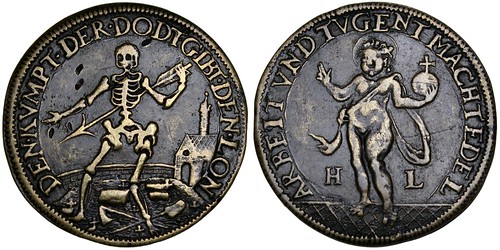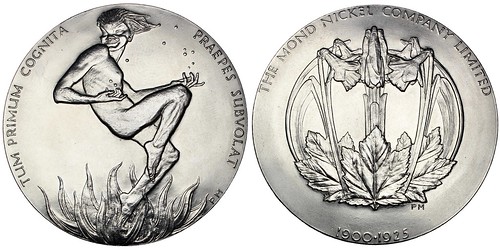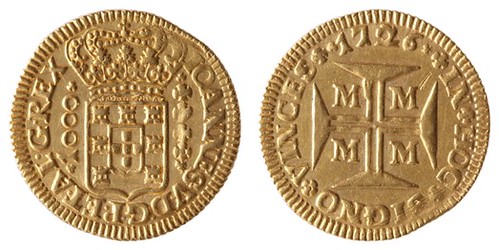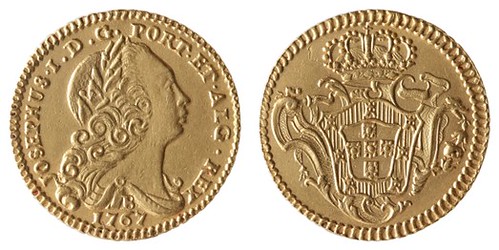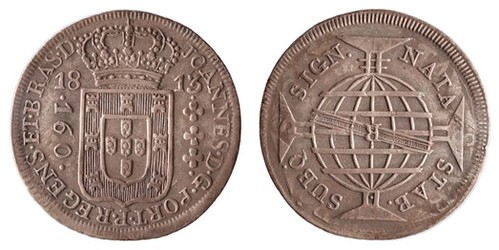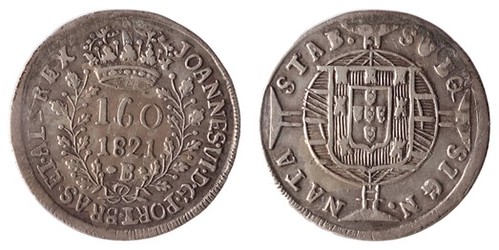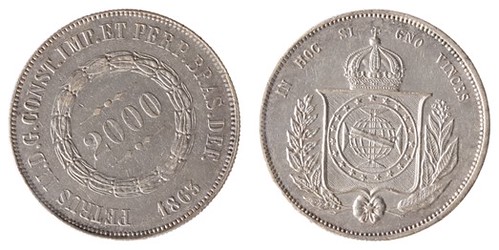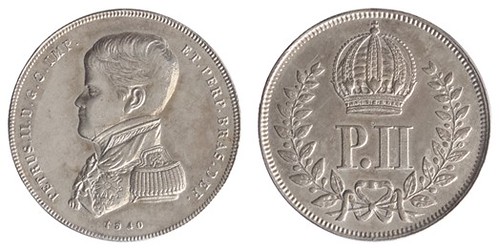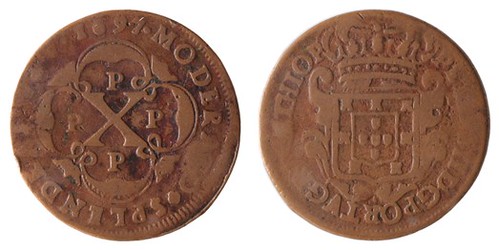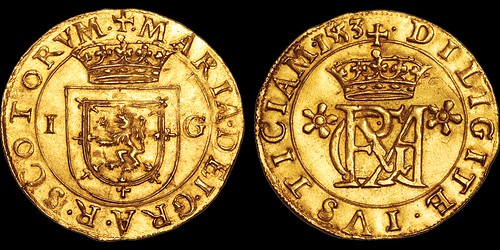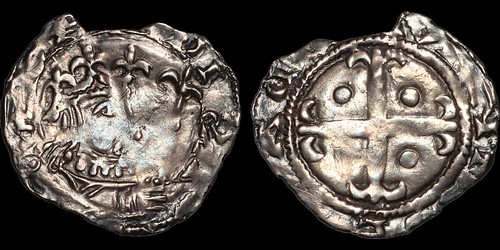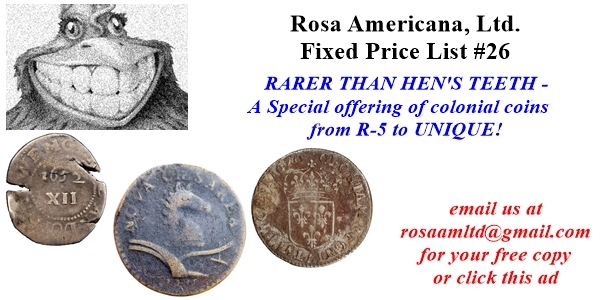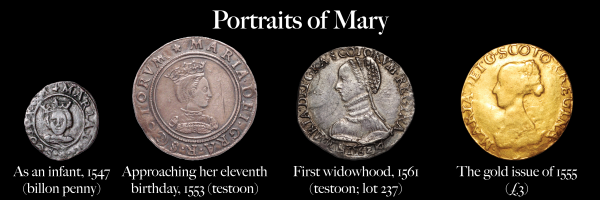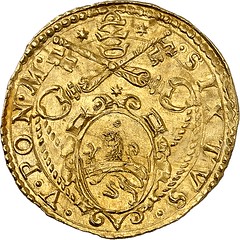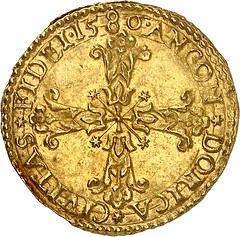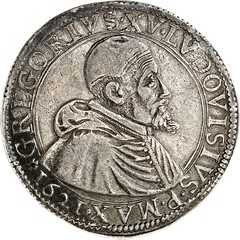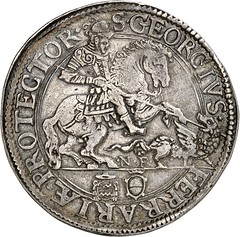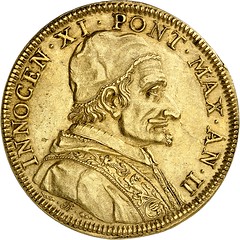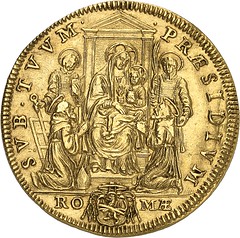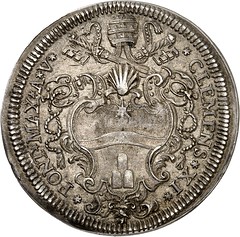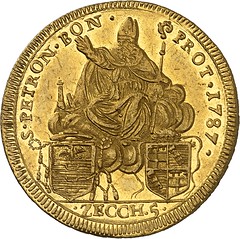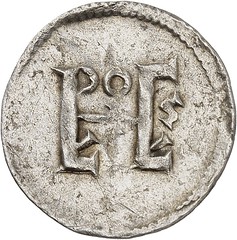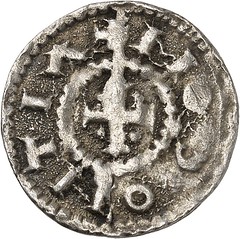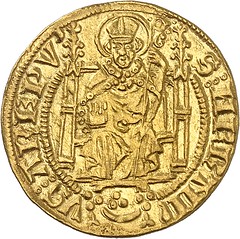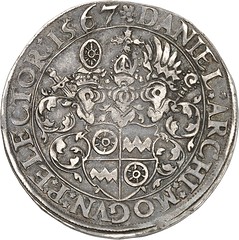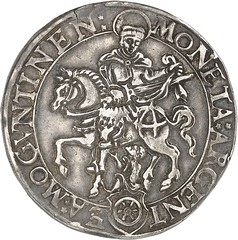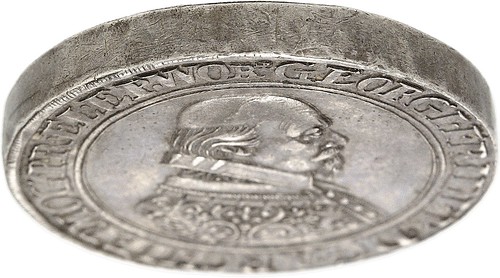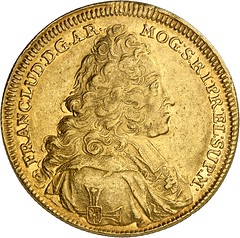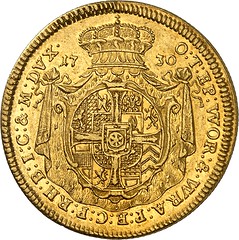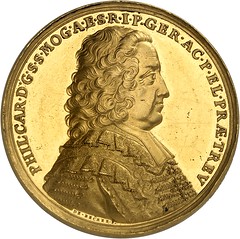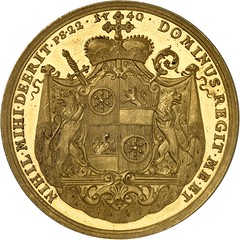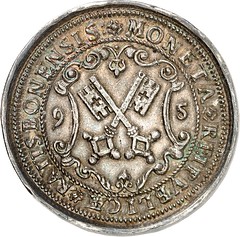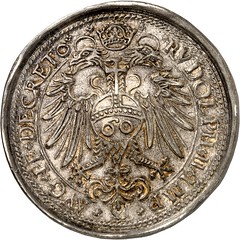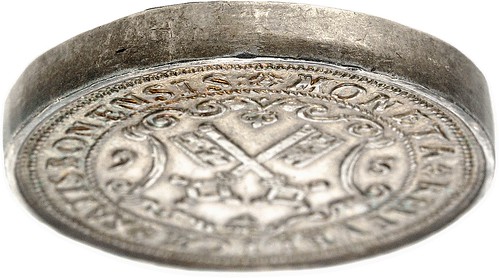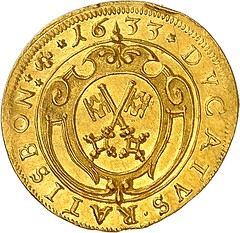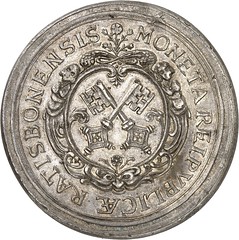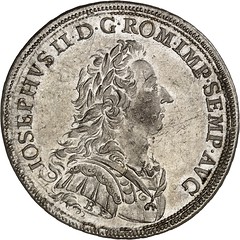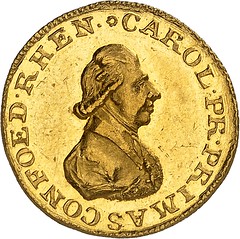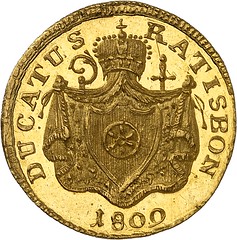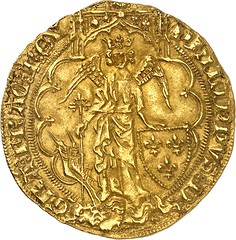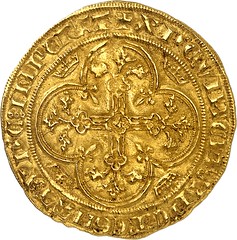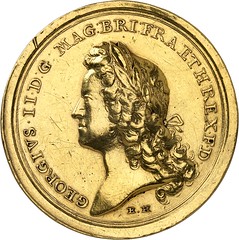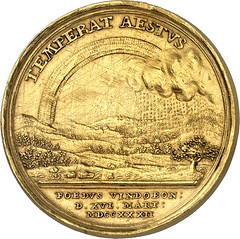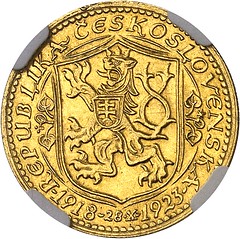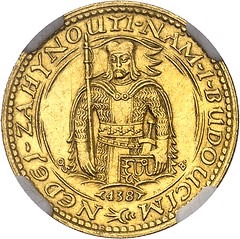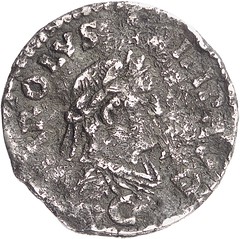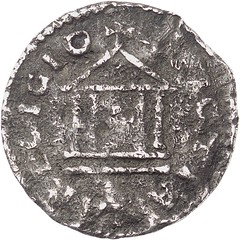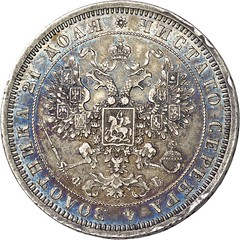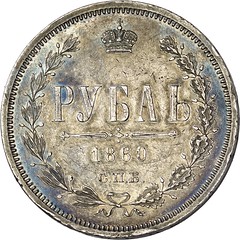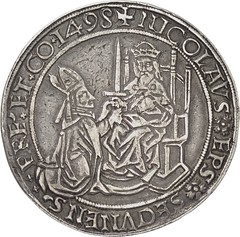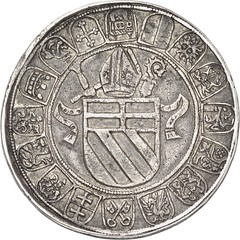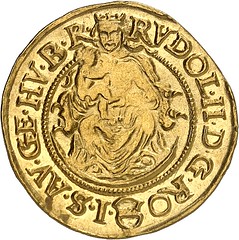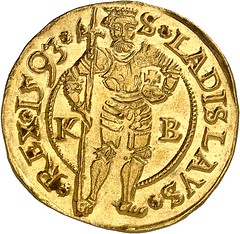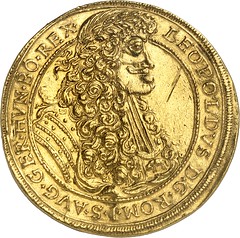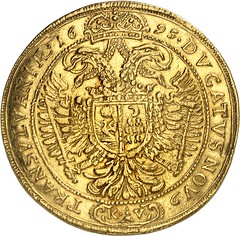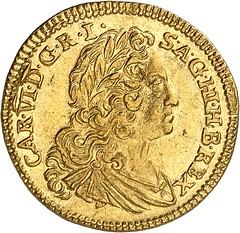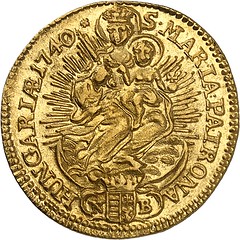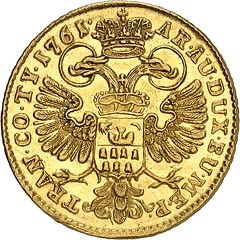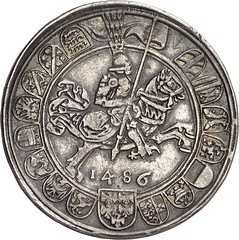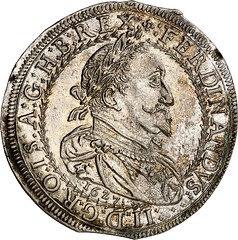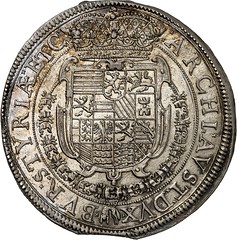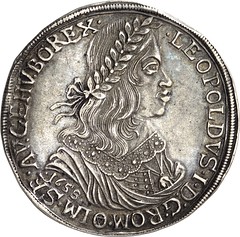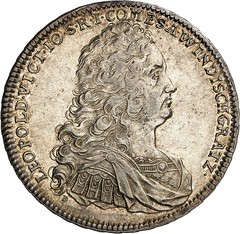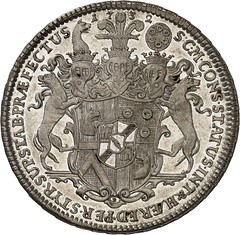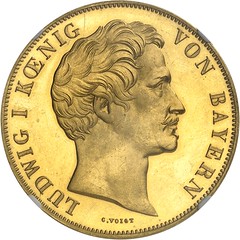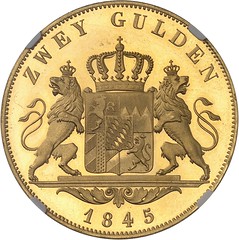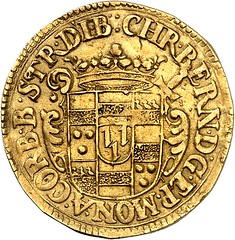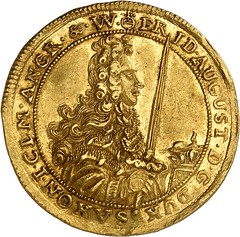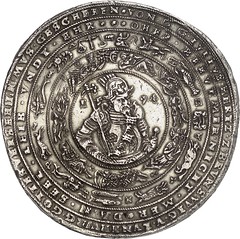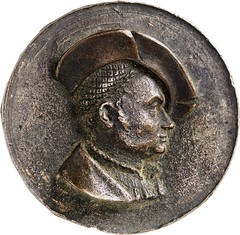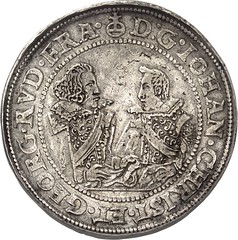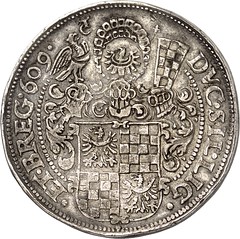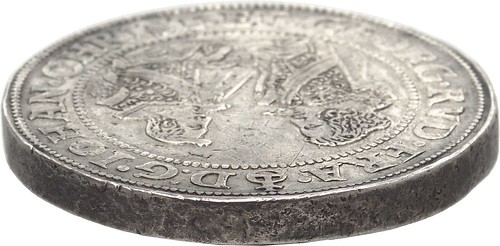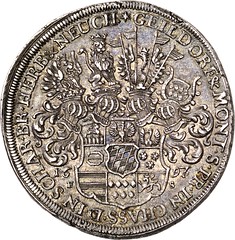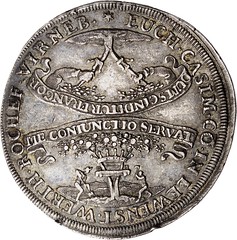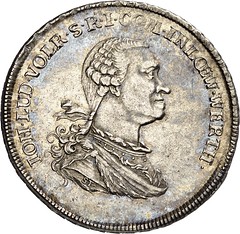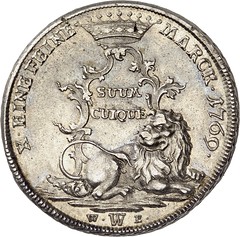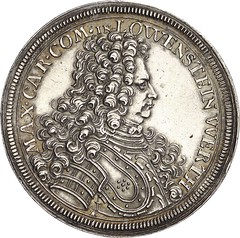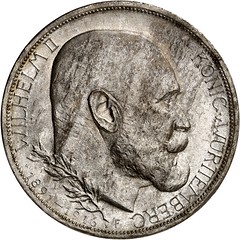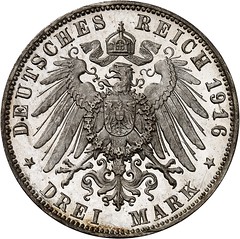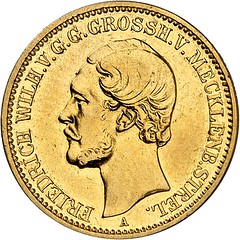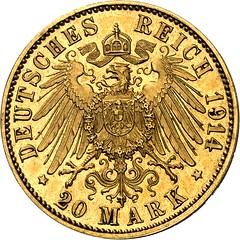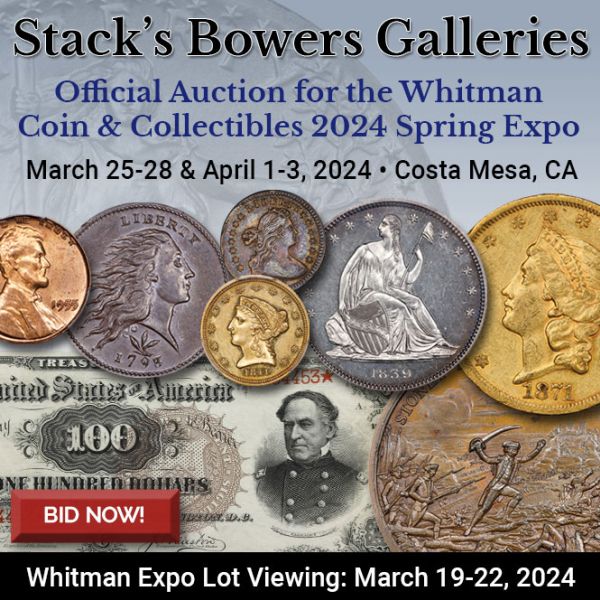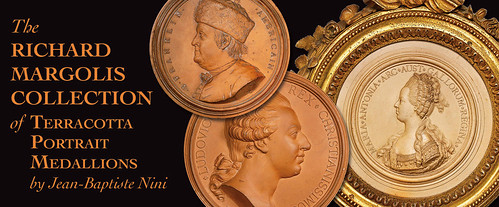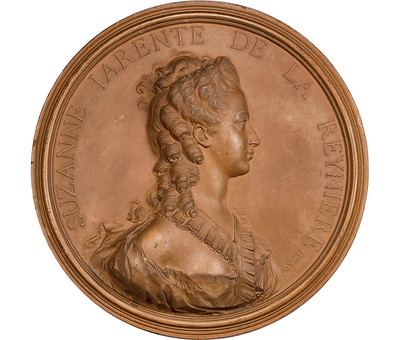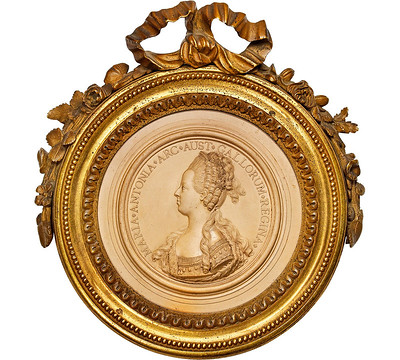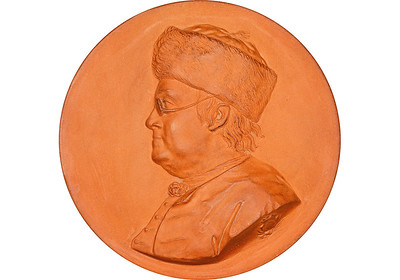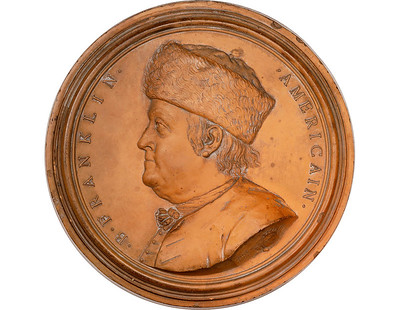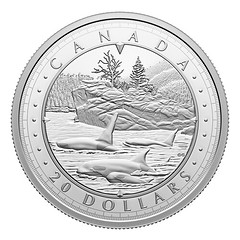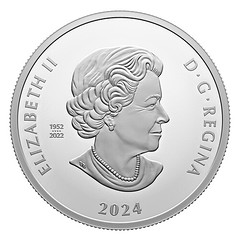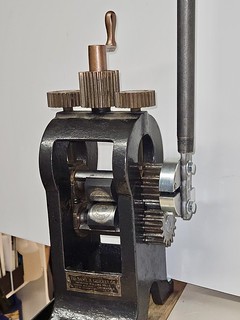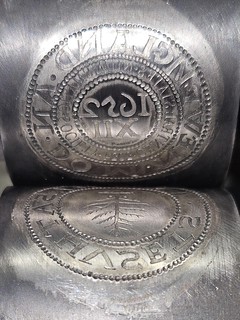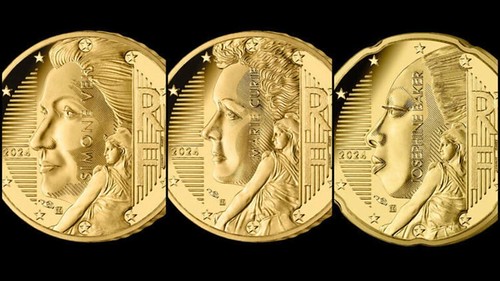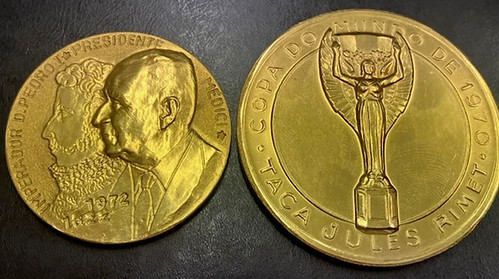
Visit our NBS Sponsors
About UsThe Numismatic Bibliomania Society is a non-profit association devoted to the study and enjoyment of numismatic literature. For more information please see our web site at coinbooks.org SubscriptionsThose wishing to become new E-Sylum subscribers (or wishing to Unsubscribe) can go to the following web page link MembershipThere is a membership application available on the web site Membership Application To join, print the application and return it with your check to the address printed on the application. Print/Digital membership is $40 to addresses in the U.S., and $60 elsewhere. A digital-only membership is available for $25. For those without web access, write to: Jeff Dickerson, Treasurer AsylumFor Asylum mailing address changes and other membership questions, contact Jeff at this email address: treasurer@coinbooks.org SubmissionsTo submit items for publication in The E-Sylum, write to the Editor at this address: whomren@gmail.com BUY THE BOOK BEFORE THE COINSale CalendarWatch here for updates! |
- WAYNE'S WORDS: THE E-SYLUM MARCH 17, 2024
- BERNT AHLSTROM NUMISMATIC LIBRARY, PART 1
- ERIC NEWMAN PAPER MONEY CORRESPONDENCE
- CHERRYPICKERS' GUIDE SECOND PRINT RUN ARRIVES
- NEW BOOK: CAMEO AND BRILLIANT PROOF COINAGE
- NEW BOOK: CROATIAN COINS AND BANKNOTES
- NEW BOOK: MONETARY BAMBOOS OF SUZHOU (1875-1949)
- NEW BOOK: HUNDIS IN PRINCELY STATES OF INDIA
- MAY 2024 NNP SYMPOSIUM ANNOUNCED
- NEWMAN ON THE 1913 LIBERTY NICKEL
- VIDEO: DONALD KAGIN AS COLONIAL MAN
- ROMAN REPUBLICAN DIE PROJECT UPDATE
- ON THE STATE OF STAMP COLLECTING
- NOTES FROM E-SYLUM READERS: MARCH 17, 2024
- SCOTT MILLER'S COIN CLUB BOOKLETS
- VOCABULARY TERM: PEWTER
- PETER MOUGEY (1842-1908)
- 2023 CHICAGO COIN CLUB HALL OF FAME
- WHAT KIND OF COLLECTOR ARE YOU?
- NUMISMAGRAM MEDAL SELECTIONS: MARCH 17, 2024
- VILA RICA MOEDAS AUCTION 20
- DAVISSONS AUCTION 43 SCOTLAND HIGHLIGHTS
- NOTES ON SCOTTISH COIN DESIGN
- KUENKER AUCTIONS 403-405
- KUENKER AUCTION 406
- STACKS BOWERS OFFERS NINI TERRACOTTA PORTRAITS
- VANCOUVER ISLAND GLEN GREEN'S ORCA COIN
- REPLICA PINE TREE SHILLINGS AT CSNS
- 2024 ANIMALS IN WAR & PEACE CEREMONY
- CRANE MUSEUM PAUSES LOCATION SEARCH
- LOOSE CHANGE: MARCH 17, 2024
Content presented in The E-Sylum is not necessarily researched or independently fact-checked, and views expressed do not necessarily represent those of the Numismatic Bibliomania Society.
WAYNE'S WORDS: THE E-SYLUM MARCH 17, 2024
 New subscribers this week include:
Nick Economopoulos.
Welcome aboard! We now have 7,308 subscribers.
New subscribers this week include:
Nick Economopoulos.
Welcome aboard! We now have 7,308 subscribers.
Thank you for reading The E-Sylum. If you enjoy it, please send me the email addresses of friends you think may enjoy it as well and I'll send them a subscription. Contact me at whomren@gmail.com anytime regarding your subscription, or questions, comments or suggestions about our content.
This week we open with two numismatic literature sales, five new books, updates from the Newman Numismatic Portal, notes and submissions from readers, and more.
Other topics this week include Croation coins and banknotes, Hundi scrip, the 1913 Liberty Nickel, the state of stamp collecting, fixed price and auction previews, Scottish coin design, replica Pine Tree Shillings, Nini terracotta portraits, Animals in War and Peace medals, and the Crane papermaking museum.
To learn more about Bernt Ahlström, the Cherrypickers' Guide, the bamboo money of Suzhou, the next NNP Symposium, the Roman Republican Die Project, pewter, chemistry on coins, coin club literature, Peter Mougey, Professor R. Edward Davis, the Mond Nickel Company, Brazilian Gold Bars, and France's Josephine Baker coin, read on. Have a great week, everyone!
Wayne Homren
Editor, The E-Sylum
BERNT AHLSTROM NUMISMATIC LIBRARY, PART 1
Online Auction 16 from Münzen Gut-Lynt offers the first part of the numismatic library of dealer Bernt Ahlström. Here's the press release, which opens with a remembrance by Arne Kirsch. -Editor
The Bernt Ahlström Numismatic Library, pt. 1
 The Online Auction House Münzen Gut-Lynt is pleased to offer on the opening day of the Gut-Lynt auction weekend from April 6 to 7, 2024 (encompassing Gut-Lynt 15, Coins and Medals, and Gut-Lynt 16, Numismatic Literature) the first part of the numismatic library of an equally illustrious and interesting numismatic "global player" as well as comprehensive connoisseur.
The Online Auction House Münzen Gut-Lynt is pleased to offer on the opening day of the Gut-Lynt auction weekend from April 6 to 7, 2024 (encompassing Gut-Lynt 15, Coins and Medals, and Gut-Lynt 16, Numismatic Literature) the first part of the numismatic library of an equally illustrious and interesting numismatic "global player" as well as comprehensive connoisseur.
About Bernt Ahlström, 1936–2019 (Author: Arne Kirsch, numismatist of the SINCONA Group, Honorary President of the IAPN)
You will hardly find a dealer in the numismatic world who is completely unfamiliar with the name Bernt Ahlström. When I picked up my first coins as well as books on coins and medals in Schleswig-Holstein in 1978, he was already a regular guest in the far north of Germany, bringing both consignments and stories with him.
At one of our last meetings in Zurich in 2019, Bernt Ahlström reviewed his 60-year career in a few highlights – unfortunately, far too little of it has been preserved; he wrote nothing down. What remains is the memory of an outstanding numismatist, a dealer who could be found in several markets and at all the important auctions, coin fairs and exhibitions. He was one of the first internationally operating coin dealers: an extraordinary personality; a numismatic "global player" as dealer and auctioneer; a businessman with a feel for gaps in the market and the courage to take risks – and at his best "a giant in the world of coins", as one obituary put it.
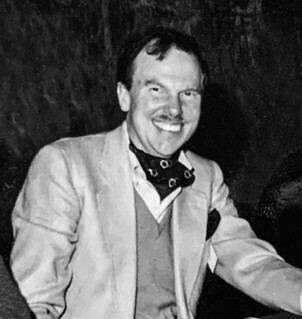 Bernt Rickard John Ahlström was born in Stockholm on March 2, 1936. In 1954 – at the age of just 18 – he opened the "B. Ahlström Mynthandel" in his native Stockholm, capital of Sweden, at his father's suggestion (who, by the way, was a passionate and well-known philatelist). And just a short time later we already find him at the legendary auction of the Farouk collection – held by Sotheby's in Cairo in February and March 1954 – as one of the buyers of the Swedish part of this enormous coin collection. In 1964 he left Stockholm (where his brother Bjarne continued to run the business there with great success up until 2004) to establish the "Galerie des Monnaies" group of companies in Lausanne/Switzerland (1964), later Geneva/Switzerland (1965) and Düsseldorf/Germany (1969, with Anders Ringberg).
Bernt Rickard John Ahlström was born in Stockholm on March 2, 1936. In 1954 – at the age of just 18 – he opened the "B. Ahlström Mynthandel" in his native Stockholm, capital of Sweden, at his father's suggestion (who, by the way, was a passionate and well-known philatelist). And just a short time later we already find him at the legendary auction of the Farouk collection – held by Sotheby's in Cairo in February and March 1954 – as one of the buyers of the Swedish part of this enormous coin collection. In 1964 he left Stockholm (where his brother Bjarne continued to run the business there with great success up until 2004) to establish the "Galerie des Monnaies" group of companies in Lausanne/Switzerland (1964), later Geneva/Switzerland (1965) and Düsseldorf/Germany (1969, with Anders Ringberg).
In 1976, he took the huge step "across the pond" with the opening of the "Galerie des Monnaies of Geneva Ltd." in New York/USA. A former branch of Chase Manhattan Bank provided the appropriate setting. He managed to achieve world record prices at auctions and sales in collaboration with renowned auction houses such as Hans Schulman Auctions, Sotheby's, Credit Suisse and Spink & Son. New York surely was a decisive milestone for him and his career, and these years marked the peak of his numismatic success. But for the entrepreneur Ahlström, there was no standing still when it came to ever expanding his "empire." Together with his second brother John Ahlström, he founded a wine store, the "Galerie des Vins", in Paris in the mid-1970s. A little later, he decided to buy a private bank in Paris, the "Crédit de la Bourse" (1976). Finally, in 1980, the prestigious Place Vendôme became the location of another branch of the "Galerie des Monnaies" sharing the premises with the renowned Italian jewelry house "Buccellati." A company brochure from around this time proudly states: "Rare coins and classical antiques will now share this superb location with examples of the world's finest handcrafted jewellery". Ahlström's group of companies now advertised the impressive locations of Geneva, Düsseldorf, New York and Paris. The ambitions of the group of companies and the breadth of the business areas were generously conceived; probably too generously – in Paris he ultimately failed.
In the course of the 1980s, Ahlström gradually closed his European businesses, returned to the USA and founded the auction house "El Dorado" with Alcedo Almanzar in San Antonio/Texas.
Also in the 1980s, he discovered a new field of business, which he conquered with his own blend of passion, persuasiveness, tenacity, networking and entrepreneurial instinct, and in which he eventually became recognized as one of the world's leading dealers and connoisseurs. We talk about memorabilia and collectibles related to the modern Olympic Games. True to his universal genius, he not only focused on medals and badges, but also became a collector of all artifacts relating to the Olympic Games. When visiting his home, it was quite possible to suddenly find yourself standing in front of an original two-man bobsleigh sled, a torch or official uniforms of game organizers, not to mention numerous pennants, flags and souvenirs. Me personally, I got the impression that only the museum in Lausanne had a larger selection of Olympic memorabilia. Bernt Ahlström passed away in December 2019 after suffering from cancer. Until his last week, he was still traveling and taking part in auctions.
Arne Kirsch, March 2024
Lot 1030: DATTARI, G. Monete imperiali greche. Numi Augg. Alexandini. Catalogo Collezione G. Dattari compilato dal proprietario. Cairo 1901. XII, 471 pp., 37 plates. 2 volumes, bound in one, half leather. Starting price: 300 EUR
Lot 1669: DOMANIG, K. Porträtmedaillen des Erzhauses Österreich von Kaiser Friedrich III. bis Kaiser Franz II. aus der Medaillensammlung des allerhöchsten Kaiserhauses. Vienna 1896. VII, 40 pp., 50 plates. Half-linen. Starting price: 100 EUR
Lot 1918: VAN DEN BERGH, L. Catalogue descriptif des Monnaies, Méreaux, Jetons & Médailles frappés a Malines ou ayant trait a son histoire. 2 vol., Malines 1899. 86 pp., 50 plates.; frontispiece, 143 pp., 26, 91 plates. Bound in one volume, , half leather. Starting price: 150 EUR
Lot 1591: ACADÉMIE ROYALE DES MÉDAILLES ET DES INSCRIPTIONS (Editor). Medailles sur les principaux evenements du regne de Louis le Grand, avec des explications historiques. Paris 1702. 292 pp. Leather binding. Starting price: 150 EUR
Lot 1926: VAN LOON, G. Histoire Métallique des XVII Provinces des Pays-Bas, depuis l'abdication de Charles-quint, jusqu'a la paix de Bade en 1716. Vol 2. Den Haag 1732. 541 pp. with illustrations. Half leather. Starting price: 250 EUR
As usual, you can find the online catalog for Gut-Lynt Auction 16 on our auction platform www.auktionen.gut-lynt.de – please register in time.
On Instagram "muenzen_gut_lynt" we accompany each auction with exclusive selections and further information about the auctions. On our website www.gut-lynt.de we offer you previews and reviews of auctions, up-to-date information on auction dates and consignment deadlines as well as all the necessary links to the auction platform (registration, online catalog, etc.).
If you have any questions regarding Gut-Lynt coin auctions, please do not hesitate to contact us at info@gut-lynt.de or call us on (+49) 02156 4874819. We look forward to hearing from you.
ERIC NEWMAN PAPER MONEY CORRESPONDENCE
The Heritage auction of researcher Eric P. Newman's correspondence files is a great opportunity for researchers and bibliophiles. Here are additional highlights submitted by Bruce Hagen and Maureen Levine. Thanks! -Editor
Selections from the Eric P. Newman Correspondence Files
Closing Soon
Eric P. Newman's fascination with paper money led to a lifetime of scholarly research and prolific writing
on the subject. His correspondence files are now offered unreserved in Heritage's Showcase Auction
#63247, closing Monday March 25, 2024, at 7:00 P.M. CDT. Decades of documents include letters
between Eric and other legendary currency specialists from A
to Wismer. Many of the lots contain
priceless artifacts that will open avenues for further study and enjoyment.
Below are some vignettes
that will provide intriguing insights into Eric's perspectives on paper money:
Lot 52041. Research Files on Colonial and Continental Paper Money. Featured within is an unpublished manuscript on Colonial notes by William West Bradbeer, best known for creating the numbering system for Confederate currency references.
To read the complete lot description, see:
Various Sources. Research Files on Colonial and Continental Paper Money. Files include: a faded photocopy of an unpub...
(https://coins.ha.com/itm/miscellaneous/various-sources-research-files-on-colonial-and-continental-paper-money-files-include-a-faded-photocopy-of-an-unpublished/a/63247-52041.s)
Lots 52042 and 52043. Research Files on Banking History and Paper Money Issues of Missouri and Early Research Materials on Missouri Paper Money. To date there is no book on Missouri Obsolete currency, nor is there a comprehensive reference work on the State's numismatics. These complementary lots contain invaluable material for the specialist and, perhaps, future author.
To read the complete lot descriptions, see:
Various Sources. Research Files on Banking History and Paper Money Issues of Missouri. A large archive of three boxes...
(https://coins.ha.com/itm/miscellaneous/various-sources-research-files-on-banking-history-and-paper-money-issues-of-missouri-a-large-archive-of-three-boxes-of-material-/a/63247-52042.s?ic4=ListView-ShortDescription-071515)
Newman, Eric P. Early Research Materials on Missouri Paper Money. Present are: a file of Eric P. Newman's early work ...
(https://coins.ha.com/itm/miscellaneous/newman-eric-p-early-research-materials-on-missouri-paper-money-present-are-a-file-of-eric-p-newman-s-early-work/a/63247-52043.s)
Lot 52044. Research Files on Early American Paper Money Outside of Missouri. Here researchers
will find insightful correspondence on many aspects of the subject from a veritable Who's Who
of
Obsolete currency luminaries.
To read the complete lot description, see:
Various Sources. Research Files on Early American Paper Money Outside of Missouri. Files include: correspondence (c. ...
(https://coins.ha.com/itm/miscellaneous/various-sources-research-files-on-early-american-paper-money-outside-of-missouri-files-include-correspondence-c-1965-dealing-with-a/a/63247-52044.s)
Lot 52058. Files on U.S. Paper Money. Fred Marckhoff's groundbreaking articles for the Numismatic Scrapbook in the early 1960s were mainly based on correspondence and manuscripts in this lot. They would be an apt foundation for a reference work on American Western and Territorial Paper Currency.
To read the complete lot description, see:
Marckhoff, Fred R. Files on U.S. Paper Money. Lot includes: material from Fred Marckhoff's papers primarily related t...
(https://coins.ha.com/itm/miscellaneous/marckhoff-fred-r-files-on-us-paper-money-lot-includes-material-from-fred-marckhoff-s-papers-primarily-related-to-purchases-of-paper/a/63247-52058.s)
Lot 52067. Research and Publication Files for the Fifth Edition (2008) of Newman's Book, The Early Paper Money of America. Debate over which is the most significant of multi-edition titles is inevitable, but the fifth edition of The Early Paper Money of America was a labor of love and a collaboration that initiated color images, plates, and numerous updates making it an essential book as influential as Crosby. (Note that the files for the previous editions are also included in the sale as lots 52063 through 52066.)
To read the complete lot description, see:
Newman, Eric P. Research and Publication Files for the Fifth Edition (2008) of Newman's Book, The Early Paper M...
(https://coins.ha.com/itm/miscellaneous/newman-eric-p-research-and-publication-files-for-the-fifth-edition-2008-of-newman-s-book-the-early-paper-money/a/63247-52067.s)
Lot 52071. Research and Publication Files for "Discovered! The First Engraving of an Audubon Bird" (2010), written by Newman with Robert M. Peck. The hunt for Audubon's first published engraving of a bird culminated in the discovery of a running grouse vignette by Fairman, Draper, Underwood & Co. This article (published in the Fall 2010 issue of the Journal of the Early Republic) received widespread attention, as the discovery unveiled within it is important not only from a numismatic point of view but from the perspectives of naturalists, ornithologists, and anyone interested in the broad category of Americana.
To read the complete lot description, see:
Newman, Eric P. Research and Publication Files for "Discovered! The First Engraving of an Audubon Bird" (2010), written by Ne...
(https://coins.ha.com/itm/miscellaneous/newman-eric-p-research-and-publication-files-for-discovered-the-first-engraving-of-an-audubon-bird-2010-written-by-newman-with-robert/a/63247-52071.s)
Lot 52093. Publications on Various Aspects of Paper Money. There are several notable works here from Gene Hessler to Nolie Mumey, and eclectic monographs in between.
To read the complete lot description, see:
Various Authors. Publications on Various Aspects of Paper Money. Lot includes: Gene Hessler's 1993 The Engraver's ...
(https://coins.ha.com/itm/miscellaneous/various-authors-publications-on-various-aspects-of-paper-money-lot-includes-gene-hessler-s-1993-the-engraver-s-line-george-b/a/63247-52093.s)
Eric P. Newman never lost his passion for paper currency and his book, The Early Paper Money of America, is the standard reference work on the subject. Collectors and researchers will want to peruse the items in this sale while there is still time. This U.S. Coins Showcase auction closes on Monday, March 25, at 7:00 PM CT. Please log onto ha.com/63247 to view lots and bid.
Numismatic research is never really complete - there is always more to discover. Even the venerable 1875 Sylvester Crosby work on The Early Coins of America, still used today, has inspired and spawned numerous complete books and specialty clubs focusing on research areas that were mere chapters in the original work. Who will stand on the shoulders of this numismatic giant and see even farther into the future of the field? -Editor
CHERRYPICKERS' GUIDE SECOND PRINT RUN ARRIVES
Whitman Publishing reported a sellout of the first printing of the new sixth edition, volume II, Cherrypickers' Guide to Rare Die Varieties, prompting a second print run, which is now available. Here's the press release -Editor
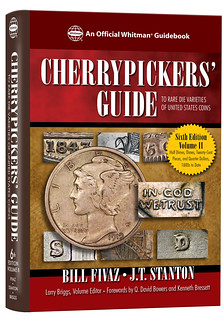 Whitman® announces the release of a second print run of the Cherrypickers' Guide to
Rare Die Varieties: Volume II, 6th Edition. The wait is finally over for this highly anticipated reference, which
originally debuted at last year's ANA World's Fair of Money in Pittsburgh.
Whitman® announces the release of a second print run of the Cherrypickers' Guide to
Rare Die Varieties: Volume II, 6th Edition. The wait is finally over for this highly anticipated reference, which
originally debuted at last year's ANA World's Fair of Money in Pittsburgh.
The Cherrypickers' Guide was one of our best book sellers of the entire year,
said Whitman vice president
of sales Dawn Burbank. When it released at the show, collectors and dealers bought every advance copy we
had. We couldn't keep them on the shelves, and overall, we sold the entire print run of over 7,200 copies in
just under four months.
Burbank added, We expect the second print run to sell just as fast, based on pent-up
demand for the wildly popular title.
The 320-page spiralbound-hardcover Cherrypickers' Guide can be ordered for $39.95 online now at whitman.com, Whitman's Ebay Store, Amazon, and will be available in bookstores, hobby shops, and other online retailers nationwide later this month. Ask your favorite coin dealer for a copy!
Few books have excited the coin-collecting community like the Cherrypickers' Guide series. Since the first
edition burst onto the scene in 1990, thousands of hobbyists have been searching for the rare die varieties
described inside. This handy book tells you how to cherrypick
—that is, how to examine coins that look
normal at first glance but have unusual characteristics—such as doubled and tripled dies, overdates,
repunched mintmarks, and other features that can reveal a common coin to be a rare and valuable variety.
With the close-up photographs and descriptions inside, you'll learn exactly what to look for.
For this volume, Cherrypickers' Guide co-authors Bill Fivaz and professional numismatist Larry Briggs feature more than 440 die varieties, including nearly 80 new additions. The book covers Capped Bust and Liberty Seated half dimes, dimes, and quarters; Barber dimes and quarters; Mercury dimes; Roosevelt dimes; twenty-cent pieces; Standing Liberty quarters; and Washington quarters, including the State, D.C., Territorial, and National Parks series.
Cherrypickers' Guide, Volume III to be released this Summer
The Cherrypickers' Guide to Rare Die Varieties of United States Coins, Sixth Edition, Volume III is
scheduled for release this summer prior to the ANA World's Fair of Money 2024 in Chicago. It will cover
half dollars through federal gold denominations, bullion coins, commemoratives, and the Philippines. For the
first time ever in Cherrypickers' this volume features Greysheet-based pricing and GSID numbers that
identify and link a coin across the entire family of Whitman Brands products, such as the Greysheet online
pricing tool, CDN Exchange, and the Greysheet mobile app.
I am very proud of the product headed to press later this month—the high level of community collaboration,
updated content, and added features such as GSID have taken this high-demand product to the next level,
said Whitman Cherrypicker's Guide production editor Brandon Hall. The cherrypicking community should
be very excited for the next volume!
Author Bill Fivaz believes CPIIIv6
to be the best Cherrypicker
ever.
SPECIFICATIONS
Title: Cherrypickers' Guide to Rare Die Varieties of United States Coins, Sixth Edition, Volume II
Authors: Bill Fivaz, J.T. Stanton
Forewords: Kenneth Bressett, Q. David Bowers
Editor: Larry Briggs
ISBN: 0794848338
Binding: Spiralbound hardcover
Dimensions: 6 x 9 inches
Pages: 320
Photos: 707
Retail $39.95 U.S.
https://whitman.com/cherrypickers-guide-volume-ii-6th-edition/
To read the earlier E-Sylum articles, see:
NEW BOOK: CHERRYPICKERS' GUIDE, 6TH EDITION, VOLUME II
(https://www.coinbooks.org/v26/esylum_v26n25a05.html)
CHERRYPICKERS' GUIDE SECOND PRINT RUN
(https://www.coinbooks.org/v26/esylum_v26n37a08.html)
NEW BOOK: CAMEO AND BRILLIANT PROOF COINAGE
A revised edition of Rick Tomaska's book Cameo and Brilliant Proof Coinage of the 1950 to 1970 Era
is being published. Here's the announcement.
-Editor
 The long-awaited revised edition of my 1991 book
The long-awaited revised edition of my 1991 book Cameo and Brilliant Proof Coinage of the 1950 to 1970 Era
is coming through our doors any day now!
The original Cameo book was a groundbreaking addition to numismatic collectors- new and veteran collectors alike. Rick Montgomery, former President of PCGS and the current President of NGC, wrote a truly fantastic foreword for this revision:
There is no one more closely associated U.S. cameo proof coinage than Rick Tomaska. No one even close. When the first edition of Cameo and Brilliant Proof Coinage of the 1950 to 1970 Era was published in 1991, it was clear that Rick was ahead of his time. Although these coins were comparatively recent issues, Rick recognized that a world of difference could exist between any two examples. For example, on 1967 Special Mint Set Kennedy half dollar might be uncommonly rich, thickly frosty, almost jewellike, while another could be comparatively flat and pedestrian. No one else, it seemed, understood the significance of these differences.
Starting from a framework of knowledge he had garnered as a dealer specializing in Prooflike and Deep Prooflike Morgan dollars, he began to explore this more-modern coinage. He approached it technically, learning about the minting process, techniques, and die life. That explained, to Rick, why these coins existed in the first place and why they existed in varying degrees of quality. At the same time, as a market-maker of cameo proof coinage, he learned precisely what was uncommon, what was scarce, and what was truly rare. His keen eye allowed him to differentiate one coin from another that, although similar, had vastly different market values. All of this research led to the first edition of this book.
Now, thirty-plus years later, these differences are well understood by all collectors in this space. I believe that's largely due to the use of the Cameo and Ultra Cameo designations by third-party grading services. It was the publication of the first edition, however, that explicitly described a formal standard for these designations. It was Rick who lobbied for the use of this standard by the grading services, supported in no small part by this book. Two coins that look different should not be graded the same, he reasoned soundly. His argument was persuasive, and NGC added the Ultra Cameo designation.
It is for these Ultra Cameo coins, with their deep frost and stark black-and-white contrast, that Rick Tomaska is best known. We're aware of coins like the 1954 Franklin half dollar graded PF-69 Ultra Cameo that fetch eye-popping, six-figure sums, and we understand the robustness and depth of the marketplace that Rick has built. But his study is much deeper. He's personally conducted comprehensive die studies of Proof Franklin half dollars, identifying top dies that NGC recognizes and attributes. He's created artful NGC holder designs and provided assistance to the NGC Registry. His contributions have taken the form of a true collaboration.
For that reason, I was touched and honored to write the foreword to this book. It is unquestionably a unique and seminal tome in this space. Rick Tomaska offered this book to collectors and dealers to enrich their enjoyment and understanding of these coins. When describing it, Rick has said that his guiding principle is for it to be useful for generations of collectors. And Rick has done it! The information contained herein is indeed of enduring value.
There you have it, folks! From the desk of Rick Montgomery himself!
The regular edition will be available for $59, while the signed Limited Edition (only 1,000 copies!) will be available for $159. If you haven't already, put your name on our pre-order list! You can either e-mail us at caitlin@ricoins.com, or give us a call at 1-800-753-2646.
To read the complete article, see:
https://randicoins.com/
For more information, or to order, see:
REGULAR EDITION CAMEO AND BRILLIANT PROOF COINAGE OF THE 1950 TO 1970 ERA
BOOK
(https://randicoins.com/catalog/regular-edition-cameo-and-brilliant-proof-coinage-of-the-1950-to-1970-era-book/)
SIGNED LIMITED EDITION CAMEO AND BRILLIANT PROOF COINAGE OF THE 1950 TO 1970 ERA
BOOK
(https://randicoins.com/catalog/signed-limited-edition-cameo-and-brilliant-proof-coinage-of-the-1950-to-1970-era-book/)
NEW BOOK: CROATIAN COINS AND BANKNOTES
Here's a Google-translated article by Hans Ludwig Grabowski discussing a new book on Croatian coins and banknotes. -Editor
 Borna Barac: Kovanice and Novcanice Republika Hrvatska 2023/24, Dodatak 1: Kovanice and Novcanice 1918 – 1945.
Borna Barac: Kovanice and Novcanice Republika Hrvatska 2023/24, Dodatak 1: Kovanice and Novcanice 1918 – 1945.
(Coins and banknotes of the Republic of Croatia 2023/24, Appendix 1: Coins and banknotes 1918 – 1945).
192 pages, hardcover, color illustrations throughout, format 17 cm x 24 cm, Zagreb 2024.
Price: 20.00 euros.
ISBN: 978-953-6388-18-9
The main part of the brand new catalog by the well-known expert on the paper money of the former Yugoslavia and Croatia, Borna Barac, who has also published books on the coins and medals of Ragusa (Dubrovnik) as well as the orders of Europe and the whole world, contains the coins and banknotes of the modern Republic of Croatia from 1993 to 2023. As is known, the euro was introduced in Croatia on January 1, 2023. For the coins, the usual information about the alloy, weight, diameter, time of issue, artist, mint and amount of the mint is provided for each issue. All circulation and commemorative coins are shown in color with the front and back and graded in up to five grades in euros. The coin section is rounded off by a catalog of circulation coin sets and special editions in blisters.
The paper money part includes the state paper money of the Republic of Croatia from 1991/92 as well as the banknotes of the National Bank of Croatia from 1993 to 2015. Private paper money issues from the period 1990/91 are also listed. This is followed by emergency banknotes from Croatian cities from 1919. As an appendix there is a catalog section with the coins and banknotes of the Croatian state from 1941 to 1944. Here you can also find the emergency banknotes from Zagreb from 1942 and partisan issues from 1942 to 1945. Also There are colored images of the front and back of the banknotes as well as important information about the circulation times, artists, printers, watermarks and of course also ratings in up to five degrees of preservation.
The new catalog dispenses with extensive introductions and explanations of the historical context, but is limited to the essentials, a clear documentation of Croatia's coins and paper money with bilingual information in Croatian and English as well as current valuations in euros. In Croatia it has already become the new standard work in a very short time and thanks to great demand.
Interested parties should contact directly: OBOL naklada doo, Zagreb, Croatia, email: bornabarac@gmail.com.
To read the complete article, see:
Neuer Katalog zu kroatischen Münzen und Geldscheinen
(https://www.geldscheine-online.com/post/neuer-katalog-zu-kroatischen-m%C3%BCnzen-und-geldscheinen)
NEW BOOK: MONETARY BAMBOOS OF SUZHOU (1875-1949)
Craig Greenbaum and John Madlon kindly responded to Ted Puls' inquiry about F. Thierry's book on Chinese bamboo money. It turns out the title is Les Bambous Monétaires de Suzhou (1875-1949) and it's available for sale on the site linked below. Thanks, everyone! -Editor
 The Monetary Bamboos of Suzhou (1875-1949)
The Monetary Bamboos of Suzhou (1875-1949)
By: François Thierry
We know, since Marco Polo, that the Chinese invented paper money, but we know less that they also used other supports for money, such as fabric, wood, rubber and bamboo. Bamboo coins mainly circulated in the lower Blue River valley at the end of the Empire and the beginning of the Republic, and particularly in the Suzhou region in Jiangsu province. Until now, these bamboo coins had hardly attracted the attention of historians and numismatists, even in China where there is little work on the subject.
This work, the first in a Western language devoted to these objects and their history, therefore fills a void: it is a synthesis which reveals the circumstances of their appearance and the reasons for their success, explains the monetary system in which they are inserted, describes the environment of traders and entrepreneurs who issued them, and studies the different types. Accompanied by a rich, largely unpublished iconography, this book studies in detail more than 350 monetary bamboos preserved in public and private collections in Europe and China and thus immerses the reader in the daily life of a Chinese province.
François Thierry is an associate professor of the University, historian and numismatist, honorary general curator in the Department of Coins, Medals and Antiques of the National Library of France where he was in charge of the collections of oriental coins from 1989 to 2015. He is the recipient of the medal from the Royal Numismatic Society 2006 and the Hirayama Prize from the Académie des Inscriptions et Belles Lettres 2018.
152 pages. 37 black and white photos and 16 color photo pages
Year of publication: 2023
Pagination: 152 p.
Size: 16 x 24 cm
ISBN: 978-2-86377-284-3
Availability: In stock
€55.00
John adds:
"This only covers Suzhou tallies - it is a narrow slice of a larger topic."
Ted Puls writes:
"Google couldn't find it, Bing couldn't find it, AbeBooks, Amazon books, Worldcat.org couldn't find it, and ChatGPT couldn't find it but wrote very poetic excuses for not finding it, The E-Sylum found it.
"Now I am noting some hesitation about the book as it is limited in scope and I don't have a Euro account. Scott Semans sent a reference for an unobtainable Chinese volume, also with a limited scope of 100 tokens, on Zeno.ru."
I suspect that upon ordering, customers would have the option of using a credit card, which would convert the price from Euros. -Editor
For more information, or to order, see:
The Monetary Bamboos of Suzhou (1875-1949)
(https://www.leopardor.fr/index.php/les-bambous-monetaires-de-suzhou-1875-1949.html)
To read the earlier E-Sylum article, see:
NOTES FROM E-SYLUM READERS: MARCH 10, 2024 : Chinese Bamboo Money Book Sought
(https://www.coinbooks.org/v27/esylum_v27n10a06.html)
NEW BOOK: HUNDIS IN PRINCELY STATES OF INDIA
Anil Bohora has published a new volume of his catalog detailing the Hundis scrip notes of India. -Editor
Anil writes:
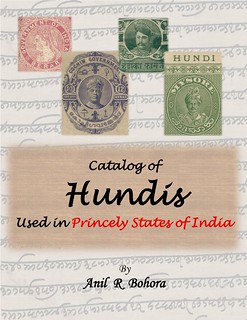 "I have just published the second volume of a catalog related to Hundis titled "Catalog of Hundis Used in Princely States of India".
"I have just published the second volume of a catalog related to Hundis titled "Catalog of Hundis Used in Princely States of India".
This book focuses on Hundis, which were a form of scrip used in India for quite a long time, used in princely states of India.
A4 Size. 408 Color Pages. Printed on Art Paper.
Price: US$60 + Shipping from India US$25
The book can be purchased by sending an email to bohoraa@yahoo.com."
Here is some background from the book's Introduction. -Editor
This book focuses on Hundis, which were a form of scrip used in India for quite a long time, used in princely states of India.
One early seventeenth-century French traveler to India, Mr. J. B. Tavernier, writes:
In this country when anyone wishes to transfer money to a distant place, without undertaking the risk of journey and expenses of conveyance, he delivers the money to a financier. The latter gives him a written paper, which is drawn on the place desired; and there the drawee hands over the money upon sight of that handwritten paper. That document they all know by the name Hundi.
While collecting and researching Hundis, it becomes very clear that Indian bankers were using a variety of innovative financial and credit instruments to facilitate trade and the movement of large sums of money across the subcontinent in a most secure and efficient manner, hundreds of years before the Western banking system.
Because of their flexibility, their extensive use, and the variety of Indian languages that were used to draft these Hundis, they have been little understood and always very confusing to the outside world.
In this book, I have tried to compile all the details about Hundis used in princely states of India in one place.
This was quite a challenge, as more than a century has gone by without producing much written information
about Hundis. For detailed information about Hundis, refer to Catalog of Hundis Used in India
.
To download sample pages, see:
https://foxly.me/HundisPrincelyStates
To read the earlier E-Sylum article, see:
NEW BOOK: CATALOG OF HUNDIS USED IN INDIA
(https://www.coinbooks.org/v26/esylum_v26n15a07.html)
MAY 2024 NNP SYMPOSIUM ANNOUNCED
The NNP Symposia are highlights of the numismatic year, bringing great speakers direct to you via Zoom. Be sure to plan for the next one. Here's the announcement. -Editor
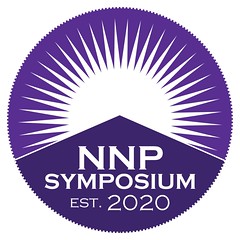 The Newman Numismatic Portal today announces the next NNP Symposium, which
will take place May 2-4, in conjunction with the Central States Numismatic Society convention in
Schaumburg, IL. Sessions will be available to in-person show attendees and will be livestreamed for
those wishing to view remotely.
The Newman Numismatic Portal today announces the next NNP Symposium, which
will take place May 2-4, in conjunction with the Central States Numismatic Society convention in
Schaumburg, IL. Sessions will be available to in-person show attendees and will be livestreamed for
those wishing to view remotely.
The NNP Symposium is a free event that brings together a variety of numismatic speakers and covers a wide array of numismatic subjects. Featuring approximately twenty presentations, attendees will easily note topics of interest. This is the eighth such event, which was launched by the Eric P. Newman Numismatic Education Society in fall 2020 in response to the pandemic.
The upcoming event features a Focus on Franklin
theme, highlighted by an appearance from Benjamin
Franklin himself, as re-enacted by Patrick McBride. Two related presentations will delve into Franklin's
numismatic connections, with Farley Grubb discussing the Continental Currency paper money, while
Khachatur Manukyan will cover Franklin's innovations in the technology of currency production.
In conjunction with the Central States Numismatic Society Iowa State Showcase, the Symposium will feature speakers with Iowa connections, including George Cuhaj, Curator of the Higgins Museum in Okoboji, IA, who will discuss the museum's National Bank notes collection. Dave Stark will speak on the history of the Iowa Numismatic Association, while Jesse Goplen, of the Elkader Auction House in Elkader, IA, will deliver a pair of presentations on German notgeld.
NNP Symposium attendees subscribe to email updates at https://nnpsymposium.org, and a full schedule of events will be posted at https://nnpsymposium.org/schedule. Zoom links for individual sessions will be publicly posted shortly before the event. Email subscription is not required to attend the Symposium, though it is encouraged for those who wish to receive event notifications. For further information on the Central States Numismatic Society convention, see https://www.csns.org/convention.
NEWMAN ON THE 1913 LIBERTY NICKEL
Newman Numismatic Portal Project Coordinator Len Augsburger provided the following report. Thanks. -Editor
The Eric P. Newman Files on the 1913 Liberty Nickel
The story of Eric P. Newman's acquisition of the five 1913 Liberty nickels from the estate of Colonel E.H.R. Green is the stuff of legend, and Newman's extensive paper trail on this iconic coin is now offered for sale through Heritage Auctions. Presented as lot 52032 in Selections from the Eric P. Newman Correspondence Files, the files reveal Newman playing detective and working toward a presentation similar to his 1962 publication The Fantastic 1804 Dollar. Newman pursued multiple research topics, not all of which were published, and this file represents a project that did not reach fruition. Still, Newman's status as owner of all five known examples (jointly, with Burdette G. Johnson) lends a unique perspective to perhaps the most famous of all American rarities.
Included here are Newman's notes on the physical description of each piece, and notes on a discussion with Vernon Sheldon in 1961, which includes tantalizing tidbits such as Says [Philadelphia coin dealer and reputed Mint insider] Ira Reed knew about 1913 Lib Head nickels…Secret Service has big file on Ira Reed.
Newman tracked down a daughter of Samuel Brown, the Mint employee who initially marketed the coins, and includes notes on that conversation here. Newman was further in touch with George Walton, the owner of the lost
1913 Liberty nickel that came to light in recent years.
This writer could not help asking Newman, c. 2014, if he regretted selling the coins. Newman obviously recognized the financial implications, but at the same time he was somewhat ambivalent, as he considered the coins a clandestine issue and not truly significant except in an illegitimate sense. His comment to George Walton on January 3, 1962, sums it up well: I have just completed a book on the 1804 dollar which will be published, this spring, and I am hopeful that it will end any doubts about the matter. It is a shame to have to devote so much time to bad coins but I have not neglected my desire to write about genuine ones.
Image: Newman queries Smithsonian Curator Vladimir Clain-Stefanelli on the 1913 Liberty nickel, March 14, 1962
Link to Heritage Auctions offering of the Newman 1913 Liberty Nickel research papers:
https://coins.ha.com/itm/miscellaneous/various-sources-research-files-on-the-1913-liberty-nickel-files-include-correspondence-1939-1972-related-to-the-1913-liberty-nickel/a/63247-52032.s?ic4=ListView-ShortDescription-071515
Link to the Newman Correspondence Files Showcase Auction sale home page:
https://coins.ha.com/c/auction-home.zx?saleNo=63247&ic=breadcrumb-coins-121913-interior
VIDEO: DONALD KAGIN AS COLONIAL MAN
The David Lisot Video Library on the Newman Numismatic Portal can be found at:
https://nnp.wustl.edu/library/multimediadetail/522852
We highlight one of his videos each week in The E-Sylum. Here's one from 2005 with Don Kagin performing as "Colonial Man." -Editor
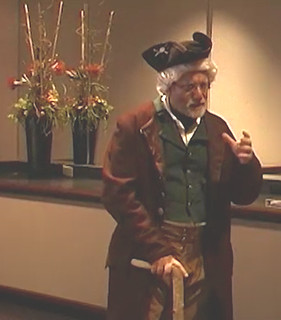 A firsthand account of the beginnings of coinage and paper currency in Colonial America. Speaker(s): Donald Kagin, Ph.D.
A firsthand account of the beginnings of coinage and paper currency in Colonial America. Speaker(s): Donald Kagin, Ph.D.
Such performances are a great way to liven up a coin show and connect with the general public. -Editor
To watch the complete video, see:
Colonial Man
(https://nnp.wustl.edu/library/book/557170)
ROMAN REPUBLICAN DIE PROJECT UPDATE
The Roman Republican Die Project (RRDP) has added another batch of coin listings. -Editor
Another batch of Roman republican coin types has just been released to the Roman Republican Die Project (RRDP). The new release significantly expands the time period of issues that have been processed, since it includes early republican didrachms, as well as late republican aurei of Octavian and Antony.
The didrachm RRC 15/1 had already been processed in RRDP but was revised as part of the current release so that all specimens in CRRO have now been analyzed and appear in the die pages.
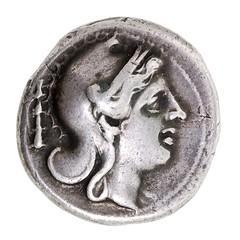

ANS 1969.83.35. Didrachm, RRC 22/1 (265-242 BCE). 6.54g. Gift of E.R. Miles. Control marks: Club/TT.
This release includes issues that were processed with the assistance of students at Sapienza Università di Roma as part of an internship supervised by Lucia Carbone, Andrew M. Burnett Associate Curator of Roman Numismatics. The subtypes of RRC 366/1 were transcribed by Isobel Wilkes (366/1a) and Micol Mazzoli (366/1b and 366/1c). Crawford distinguished the three subtypes based on the control marks: obverse symbol (366/1a), obverse letter flanked by dots (366/1b), and reverse letter usually followed by a dot (366/1c). For 366/1a, Michael Crawford lists 27 control symbols (RRC, Table XXXI). Richard Schaefer, however, identified only 23 dies, with one additional die provided by CRRO specimens for a total of 24. The RRDP dies do not include the comb, spear, or thyrsus listed by Crawford. It is likely these three symbols, the first of which Crawford only knew from Ernest Babelon (Annia 2), were actually confused with other symbols. The dies identified as spear and thyrsus could have been worn specimens of the arrow or sword in scabbard, while the symbol Babelon identified as a comb could have been the syrinx. For 366/1b, Schaefer has identified a die with each letter of the Latin alphabet, except H. For 366/1c, Crawford only knew of two reverse dies, with letters A (no dot) and B (with dot). Schaefer has added a third die with the letter C followed by a dot, known only from a single specimen.
To read the complete article, see:
More Republican Issues Added to RRDP
(https://numismatics.org/pocketchange/more-republican-issues-added-to-rrdp/)
To visit the Roman Republican Die Project (RRDP), see:
Roman Republican Die Project
(https://numismatics.org/rrdp/)
ON THE STATE OF STAMP COLLECTING
Last week, Fred Holabird discussed the state of the collectibles market, including stamps and First Day Covers. -Editor
Fred Liberatore writes:
 "I would like to disagree with Mr. Holabird concerning the state of philatelics. It is a
dying hobby. In Nashua, NH, there is a combined coin and stamp show held monthly. The stamp
dealers are all in their late 70's and beyond. Their customers are also, shall we say, elderly. I
have yet to see any young people buying stamps. Gummed, uncanceled stamps, in sheets,
commemoratives, with plate blocks from the 1940's and 1950's cost HALF face value. Later
stamps, plate blocks and otherwise uncanceled can be had for HALF face value. Even 1 and 2
cent stamps from the 1920's and 1930's are available at HALF face value as long as they are
uncanceled. Bottom line, most cancelled stamps, even old ones, have little value. Stamps prior
to 1920 may have value but no dealer was all that interested in them, even in an extensive
collection.
"I would like to disagree with Mr. Holabird concerning the state of philatelics. It is a
dying hobby. In Nashua, NH, there is a combined coin and stamp show held monthly. The stamp
dealers are all in their late 70's and beyond. Their customers are also, shall we say, elderly. I
have yet to see any young people buying stamps. Gummed, uncanceled stamps, in sheets,
commemoratives, with plate blocks from the 1940's and 1950's cost HALF face value. Later
stamps, plate blocks and otherwise uncanceled can be had for HALF face value. Even 1 and 2
cent stamps from the 1920's and 1930's are available at HALF face value as long as they are
uncanceled. Bottom line, most cancelled stamps, even old ones, have little value. Stamps prior
to 1920 may have value but no dealer was all that interested in them, even in an extensive
collection.
"I once bought some uncanceled stamps from a coin dealer at half face value. He remarked that "Stamps are like cockroaches, hard to get rid of." I regard uncanceled stamps as an interest free loan to the Post Office which comes due when I lick-'em and stick-'em."
Fred Holabird responds:
"I also mentioned covers, but stamps as well, as long as they have certs or are rare. I did not comment on shows. Stamp shows have been weak for decades. But our market is very strong in:
- Rare stamps and stamp sets
- Civil war covers
- Historical geographic covers
- Steamer, ship covers
- Express covers
"Our weak market is for COMMON stamps and commemoratives. I agree on the statement about common material by the sheet at a fraction of their face value. I do think that the government SHOULD BUY BACK UNUSED SHEETS at face.
"First day covers are common in the millions, but we still sell them, hundreds at a time. Look at the auction results."
Rare items usually stay that way. Common items are common forever.
While I agree that it would be great if the USPS would buy back its unused stamps, I can't see that ever happening because of the personnel and training costs involved - employees would have to learn to recognize the gazillions of previously published stamps, do the math to add up their face value, and be on guard for counterfeits. Look at what happened to the U.S. Mint when it paid to buy back mutilated coins - counterfeiters came along and amp'd up the volume. It would be too tempting a crime. Plus, the original buyers knew the only way they would be ensured of getting their money's worth would be to use the stamps as intended - for postage. As collectors, they were speculating that their value would go up. It didn't work out that way. How many original uncirculated rolls of state quarters have ended up in circulation?
For a look at the opposite end of the stamp market, here's a recent New York Times article about what could become the most expensive U.S. stamp ever sold. -Editor
 William Gross said to sell it all, a command that would have made Wall Street shudder if he had been talking about his huge portfolio of bonds.
William Gross said to sell it all, a command that would have made Wall Street shudder if he had been talking about his huge portfolio of bonds.
But he was talking about his huge portfolio of postage stamps, and Charles Shreve — a stamp dealer who built Gross's collection for him — has spent years carrying out the sell order.
The sell-off will conclude in New York with a sale that will feature a tiny 1-cent stamp from 1868 — a used stamp with a silhouette of Benjamin Franklin that is partly blocked by the curve of the postmark. It is known among collectors as the Z-grill.
The auction house that will sell it on June 14 is predicting that it will go for $4 million to $5 million. That would make it the most valuable U.S. postage stamp. It would still trail the 1-cent magenta from British Guiana, which sold for $8.3 million in 2021.
The Z-grill is one of only two such stamps known to exist. The other has been owned by the New York Public Library since the 1920s. They were apparently the only survivors from among thousands printed. The others were thrown away, having been sent by tax assessors mailing income tax forms in March 1868
and publishers dispatching circulars, according to Scott Trepel, the president of Robert A. Siegel Auction Galleries, the firm handling the sale.
To read the complete article, see:
A Tiny Stamp That May Sell for Millions
(https://www.nytimes.com/2024/03/11/nyregion/z-grill-stamp-auction.html)
To read the earlier E-Sylum article, see:
HOLABIRD ON THE COLLECTIBLES MARKET
(https://www.coinbooks.org/v27/esylum_v27n10a08.html)
NOTES FROM E-SYLUM READERS: MARCH 17, 2024
Chemistry on Coins
David Levy writes:
"I´ve got two very smart and charming daughters. They used to collect a few coins when I made them to join me in coin hunting through coin shops when they were just kids. They dont actively collect anymore but are fond of the few dozens of coins they gathered. One of them, Ana Carolina (aka Carol) decided to follow her dad´s footsteps and will apply for chemical engineering in a year. I was very surprised (positively!!) when I caught her examining one of her coins in particular - a 1976 Greece 10 drachmai (KM# 119; Numista 559) featuring an atom and Democritus (from Wikipedia: Democritus was an Ancient Greek pre-Socratic philosopher from Abdera, primarily remembered today for his formulation of an atomic theory of the universe).
"That kept me wondering, are there many other coins featuring chemical elements or chemistry concepts? I´m aware of a Tuvalu non-circulating coin featuring the periodic table and that's it. Any others? Perhaps with the help of this group young Carol would start a collection of her own and the world will get a new numismatist."
Great question. What other chemistry coins are out there? Has anyone already compiled such a list? -Editor
To read the complete Numista entry, see:
10 Drachmai old lettering
(https://en.numista.com/catalogue/pieces559.html)
The Friedmans at Binion's
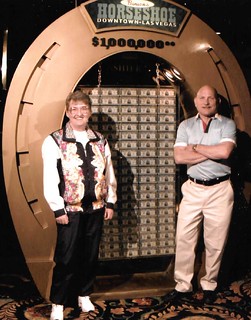 Herb Friedman writes:
Herb Friedman writes:
"I see you wrote about Ted Binion. Back when he was still alive, we used to go to his casino. Here I am with my wife Catherine near the exhibit of one million dollars."
Thanks! Popular picture spot. -Editor
To read the earlier E-Sylum article, see:
TED BINION (1943-1998)
(https://www.coinbooks.org/v27/esylum_v27n10a10.html)
Women Currency Dealers
Pete Smith writes:
"March is Women's History Month.
"For the June 11, 2023, issue of The E-Sylum, I submitted a list of women coin dealers. This generated some great feedback over the next couple of issues mentioning more American dealers and extending the discussion to world women dealers.
"This week I was asked a similar question, who was the first American woman currency dealer? Let's broaden the discussion to list any woman currency dealer and then figure out who was the first."
Pete is focused on compiling information on American dealers, and we'll look forward to everyone's input. Internationally, Pam West of London comes to mind - she deals in and publishes books on banknotes. -Editor
To read the earlier E-Sylum article, see:
U.S. WOMEN COIN DEALERS
(https://www.coinbooks.org/v26/esylum_v26n24a20.html)
THE BOOK BAZARRE
SCOTT MILLER'S COIN CLUB BOOKLETS
Jeff Burke submitted this piece inspired by a group of coin club publications. Thanks! -Editor
Scott Miller's Coin Club Booklets
Jeff Burke
Scott Miller was kind enough to loan me some coin club literature at our February 2024 meeting of the New Jersey Numismatic Society. These booklets and pamphlets included examples from The Chautauqua Coin, Stamp and Curio Club
(1946, ex F. Gordon Frost); Albany Numismatic Society
(November 1943, ex F. Gordon Frost); Ninetieth Anniversary Celebration 1860-1950 Boston Numismatic Society
; Papers Presented At Meetings of the Brooklyn Coin Club
(1941); Prospectus of the British Numismatic Society
(Second Edition, 1903); and A History of the Royal Numismatic Society 1836-1986.
Coin clubs past and present have struggled with member recruitment. The Boston Numismatic
Society (BNS) was no exception to this challenge. Founded in 1860, it thrived for a time but
eventually, due probably to an excessive caution in electing new members,
shrank to a mere
six members by 1897. (Boston Numismatic Society, p. 6). William Sumner Appleton (senior),
who held the office of secretary from the beginning, was the sole survivor of the founders.
From
1899 to 1906 just one BNS meeting was held annually. Although the Society dwindled to a
membership of three, Howland Wood, subsequent curator of the American Numismatic Society,
led a successful rejuvenation of the Society. (BNS, p. 6). While the Boston Numismatic Society
was pulling through its membership struggles, the British Numismatic Society launched, in 1903,
with members so numerous that their names spanned many pages of one of the Society's
inaugural pamphlets. (British Numismatic Society, pp. 3-9). As a stateside reader, I scanned with
curiosity the members' titles of nobility and distinction, fit to rival those of guests at any
Downton Abbey gala!
The 1946 Chautauqua booklet had a notice that caught my attention. In an advertisement for
Clarke's Better Coin Envelopes and Coin Boxes,
T. James Clarke, President of Box & Label
Works Inc. of Jamestown, New York, states that During the war we were unable to manufacture
any Coin Boxes, as our entire output was used for Medicinal purposes and for holding materials
for war needs.
(Chautauqua Coin, p. 26). Across the Atlantic, retaining minutes during the war
proved to be a difficult endeavor for the Royal Numismatic Society (RNS). Regrettably one
portion of Council minutes is missing, that covering the years from 1937 to 1941. Apparently the
then current volume was kept by the secretary of the day, John Allan, in the British Museum, and
was lost when the Coin Room was destroyed by fire in the blitz of 1941.
Fortunately, RNS
Fellows at that time were able to recall some of the lost information (History of the RNS,
Preface, p. vii).
I enjoyed being transported back in time by reading these coin club publications. I will close
with a quotation from the Boston booklet which offers a glimpse of coin collecting from the
1860s to the 1890s.
The first three decades of its existence saw the society generally active with
members in various states of the Union and abroad, holding meetings monthly and evidencing
interest equally in American and European numismatics.
(BNS, p. 6).
Looking now to the decades ahead, as a numismatist who primarily collects coins and tokens, this foray into the past has expanded my idea of collecting to include coin club medals and club literature from both the United States and around the world.
Except for those from the largest national organizations, coin club publications are generally published in small numbers and are often ephemeral in nature. They are well worth collecting, and as Jeff notes, can be a delight to read. They can contain great information that might otherwise be lost to posterity. -Editor
VOCABULARY TERM: PEWTER
Here's another entry from Dick Johnson's Encyclopedia of Coin and Medal Terminology. -Editor
Pewter. A high tin content white metal alloy, usually very soft and infrequently used for striking medallic items. The finest pewter is alloyed with antimony or copper (sometimes alone, sometimes in combination), most pewter, however, is alloyed with lead. In numismatic literature any item described as pewter is suspect, its true composition may be any of several white metal alloys or pure tin! Thus items described as pewter may be tin, or tin items may be called pewter, it is difficult to ascertain any white metal alloy by inspection alone.
Pewter darkens in time. It is bright gray when first struck but tones depending upon the lead content – the more lead the darker gray the alloy tones.
Fine pewter is 80 tin, 20 copper which produces an attractive color with good strength; eating utensils have been made of this alloy. Trifle pewter or black pewter is 60 tin, 40 lead, it is dark in color, easy to work with but cannot be used for eating utensils because of the lead content. The best tin-antimony alloy is 83 tin, 17 antimony, but this is difficult to work with (cannot be turned on a lathe, for example). For medallic items any pewter formula is satisfactory to strike (unless the lead content is too great, as it becomes too soft).
Because it is so soft, any pewter is easy to strike in a medal press; however, it cannot be given a patina finish. Like all white metal alloys (and unlike most medal compositions) it does not work harden. Because of the tin content it does exhibit reverse shadows (from surface displacement during striking where such area remains bright while all the rest of the piece will darken.
Pewter cups were once awarded as prizes. Today, however, pewter is not included in medal rank and is not used for prize medals. Workers in pewter are called triflers.
To read the complete entry on the Newman Numismatic Portal, see:
Pewter
(https://nnp.wustl.edu/library/dictionarydetail/516475)
PETER MOUGEY (1842-1908)
E-Sylum Feature Writer and American Numismatic Biographies author Pete Smith submitted this article on Cincinnati collector Peter Mougey. Thanks! -Editor
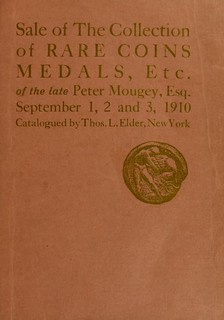 Peter Mougey was not well known as a coin collector. It was only after his death that the high
quality of his collection was revealed.
Peter Mougey was not well known as a coin collector. It was only after his death that the high
quality of his collection was revealed.
Pierre Nicolaus Mougey was born in Cincinnati, Ohio, on February 23, 1841, the son of Desire Mougey (1807-1879) and Felicite Clement Mougey (1815-1882). His parents came from France and were Ohio farmers. In numismatic references, his name only appears as Peter Mougey.
He was married in 1871 to Josephine Fieber (1848-1923) and had three sons and two daughters.
Mougey and his partner, F. M. Boyer were partners in Colter & Company wholesale grocers at Sixth and Main streets in Cincinnati. They acquired the firm after the 1880 death of founder Aaron A. Colter.
Peter Mougey joined the ANA in February 1893 as member 131. A few years later, he was listed as member number 47.
In 1901, Mougey was appointed to the board of directors of Provident Savings Bank and Trust Company.
Mougey died of pneumonia after a brief illness on February 13, 1908, and is buried with his wife and parents at Spring Grove Cemetery in Cincinnati, Ohio.
The Cincinnati Post reported on February 21, 1908:
When Probate Court Deputy Frank Behle opened the safety deposit vault of the late Peter
Mougey, head of Colter & Co., he found what is believed to be one of the finest private coin
collections in the country.
The article went on to describe storage of coins in cotton-lined boxes filed in a heavy tin box. Mougey did not share his collection and showed coins only to his wife.
The Quad-City Times of Davenport, Iowa, had a report on September 7, 1910:
Mr. (Gilbert) Mougey of Davenport recently sold his father's collection to a New York
millionaire for over $30,000. The New Yorker did not desire the entire Mougey collection, but
was anxious to secure certain coins in it in order to complete his own collection. Mr. Mougey
naturally declined to break up his complete collection and would not part with any part of it
without the New Yorker purchasing it entirely. This he did.
He made a specialty of American coins, and at the time of his death was supposed to have the most finely preserved, though not the largest, collection of this sort in existence.
The article did not identify the New York millionaire but it was subsequently revealed to be William H. Woodin. After selecting what he wanted, Woodin consigned the rest to Thomas Elder for his sale of September 1, 2 & 3, 1910. The sale was timed to run just before the 1910 A.N.A. convention held at the American Numismatic Society in New York City.
Elder emphasized the quality of the collection:
The late Peter Mougey, Esqr., may be said to have been a numismatic seer, The perfect
preservation of practically every one of his coins proves that when, many years ago, he
purchased the pieces, he looked far into the future. He prized only those coins which were
beautifully preserved, only the ones that turn out to be the most valuable today. For this reason
alone, Mr. Mougey must be regarded as one of the wisest, if not. Indeed, the most far-sighted
American numismatist of his day.
The February 1911 issue of The Numismatist reported on the sale of his collection:
Many record prices for United States coins have been made in 1910, but especially remarkable
have been the prices which have been paid for certain varieties of the old-fashioned copper cents
that were issued from 1793 to 1857. These are now the highest priced series of coins in the
world, according to a statement recently made by one of America's leading numismatists.
The highest price ever paid for a cent was $340, which was paid for an uncirculated specimen of a Liberty cap cent dated 1793 which was sold in this city last September. The former owner of the coin, the late Peter Mougey of Cincinnati, is said to have taken a trip from his home to Philadelphia to secure this specimen.
This 1793 Liberty Cap Cent is now known as Sheldon-13 in a PCGS holder as MS-64+BN.
Thomas Elder produced more than a hundred tokens and medals. These were catalogued originally by Thomas K. DeLorey in The Numismatist for June and July 1980. They were then published as Thomas L. Elder A Catalogue of His Tokens and Medals.
DeLorey-13 was a medal Elder produced to commemorate his sale of the Mougey collection. This illustration is from the book.
Pete adds:
"I made an amusing discovery while browsing through the Elder sale catalog. Lot 879 was the first half disme listed but not dated. The description is clearly for a 1792 half disme. It sold for $36, the fourth highest price paid up to that time. The coin is in my notes but I had forgotten about it. It is not in the 1792 census published in 1792: Birth of a Nation's Coinage because the coin could not be identified from the partial plate in the catalog."
2023 CHICAGO COIN CLUB HALL OF FAME
The Chicago Coin Club has announced their Hall of Fame Inductees for 2023. -Editor
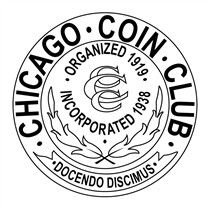 The Chicago Coin Club announced two new inductees to the clubs Hall of Fame at their December 2023
Banquet. The CCC Hall of Fame was created in 2019 to recognize a select group of prominent
numismatists that made significant contributions to numismatics on the local, state, regional and/or
national level. The original 12 inductees of 2019, one per month, were individuals who were no longer
living. Since then, Hall of Fame inductees have included living and/or deceased members.
The Chicago Coin Club announced two new inductees to the clubs Hall of Fame at their December 2023
Banquet. The CCC Hall of Fame was created in 2019 to recognize a select group of prominent
numismatists that made significant contributions to numismatics on the local, state, regional and/or
national level. The original 12 inductees of 2019, one per month, were individuals who were no longer
living. Since then, Hall of Fame inductees have included living and/or deceased members.
The 2023 class of Inductees are Mark A. Wieclaw and Professor R. Edward Davis (1878 – 1940)
Since 1919 the CHICAGO COIN CLUB has nurtured, educated and supported coin collectors of the
greater Chicago and suburban areas. Celebrating over one hundred years of continuous monthly
meetings the CHICAGO COIN CLUB lives by the motto Docendo Discimus We Learn By Teaching
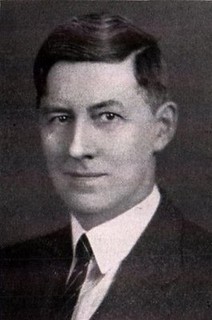 Professor R. Edward Davis served as Secretary and Treasurer of the Chicago Coin Club from its formation in 1919 until 1927, and again from 1933 to 1936. He served as president from 1929 to 1932. A founding member of the club, he was (randomly) assigned charter number 1.
Professor R. Edward Davis served as Secretary and Treasurer of the Chicago Coin Club from its formation in 1919 until 1927, and again from 1933 to 1936. He served as president from 1929 to 1932. A founding member of the club, he was (randomly) assigned charter number 1.
Professor Davis was born on January 20, 1878, in Aurora, Illinois where he grew up and first began collecting fossil specimens. He graduated from Illinois Normal University (now Illinois State University) in Normal, Illinois and from the University of Chicago.
After graduation, he began his long teaching career as a science teacher at various schools in Iowa from 1900 to 1904 before moving to Fort Scott, Kansas. He joined the faculty of the Lane Technical High School of Chicago as head of the department of chemistry in 1914, which position he occupied until his death. He was an active member of the Chicago section of the American Chemical Society and was elected vice-president of the Illinois State Chemistry Teachers Association.
Prof. Davis joined the A.N.A. in June 1909 as Member 1262, and was a founder of Branch 1 of the A.N.A. in Chicago – the Chicago Numismatic Society. From 1938 to 1940 he served as the editor of the Chicago Coin Club's Bulletin where he contributed many papers on Illinois numismatics. Among his publications was the booklet Early Illinois Paper Money.
He was elected President of the Central States Numismatic Society in 1940 but died unexpectedly after a short illness on May 4, 1940, at the age of 62. His early death cut short the career of this well-known educator and numismatist. He was survived by his wife Frances, who he married in 1906, and two daughters, Isabella and Emily.
To read the complete article, see:
Professor R. Edward Davis
(http://www.chicagocoinclub.org/projects/hof/m18.html)
 Mark Wieclaw attended his first Chicago Coin Club meeting in January 1984 and, after years of regular attendance, he became a member in June 1992 and a life member in July 1998. He served as President of the Club from 1997 to 1998 and again from 2003 to 2004, and has been a member of the board for more than 20 years.
Mark Wieclaw attended his first Chicago Coin Club meeting in January 1984 and, after years of regular attendance, he became a member in June 1992 and a life member in July 1998. He served as President of the Club from 1997 to 1998 and again from 2003 to 2004, and has been a member of the board for more than 20 years.
Mr. Wieclaw was born in Pennsylvania in 1952 and moved, as a child, to New Lenox, Illinois where his father worked at a local steel mill. His numismatic journey did not begin until he met his wife, Sally. Her father was a coin collector and that was the spark. Mr. Wieclaw has had a long career in the retail and collectibles industry in the Chicago area, working at both Harlan J.Berk, Ltd (1991-1995) and Gold Dust Coin (1995-2010).
Mr. Wieclaw's collection encompasses a wide range of subjects, from ancient coins to paper money to US coins and tokens. He has enthusiastically embraced the club motto DOCENDO DISCIMUS and is a regular presenter on a variety of numismatic topics at local high schools.
Mr. Wieclaw is a regular speaker at Club meetings and presenter at Club show and tells, having won the Cabeen award 15 times in first place and 12 times in second place. He regularly puts on educational displays at numismatic shows across the Midwest, having won multiple first-place awards and some best-of-show honors. He is an ANA certified judge in two categories.
He is also very active in numerous numismatic societies in addition to the Chicago Coin Club, where he has often served as an officer and board member. These include the Will County Coin Club (life member and past president), Illinois Numismatic Association (life member, past president, treasurer, and board member), Central States Numismatic Society (life member), Ancient Coin Club of Chicago (past president), Token and Medal Society, American Numismatic Association (life member, Presidential Award in 2000 & 2013, recipient of the Goodfellow Award, and charter member of the Dr. George F. Heath Society). Mr. Wieclaw received the Numismatic Ambassador Award from Krause Publications in 2001, and the Chicago Coin Club Medal of Merit in 2003. The book Medals and Tokens of the Chicago Coin Club, published by William A. Burd (HOF Member 17), includes many medals that Mr. Wieclaw designed, produced, and/or donated to the Chicago Coin Club.
Mr. Wieclaw married his wife Sally in 1974 and has two daughters, Jaclyn, and Alexandra.
To read the complete article, see:
Mark A. Wieclaw
(http://www.chicagocoinclub.org/projects/hof/m19.html)
WHAT KIND OF COLLECTOR ARE YOU?
In the February 2024 issue of Love Letter from the Love Token Society, Carol Bastable published an article titled "What Kind of Collector are You?" With permission, we're republishing it here. These themes are universal and likely apply to many of our readers. -Editor
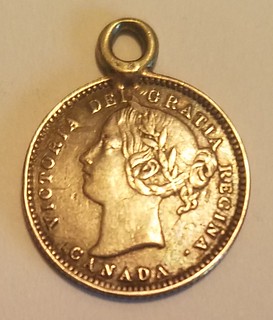 Have you ever wondered what drives one collector to collect one thing and another collector to pursue another thing? In the world of numismatics, collectors are greatly varied from coins to paper money and U.S. to ancient and foreign. Then there are the token and exomunia collectors. We fall into the exonumia field with love tokens. Yet even within our field, the options to collect are vast.
Have you ever wondered what drives one collector to collect one thing and another collector to pursue another thing? In the world of numismatics, collectors are greatly varied from coins to paper money and U.S. to ancient and foreign. Then there are the token and exomunia collectors. We fall into the exonumia field with love tokens. Yet even within our field, the options to collect are vast.
You collect what Strikes You: You do not have a specific plan or direction in your collecting. You are not building on any direction to your collecting or checking anything off of a list when you make a purchase. In fact, you probably do not have a formal want list. You are governed by what jumps out at you and grabs your attention. Often this is how many collectors start out. After being immersed in collecting for some time, you may hone your interests more.
You collect for reasons of Sentiment: You are collecting love tokens that remind you of people or things in your life. You may have assembled a family tree of initialed love tokens representing your family or you may purchase initialed love tokens and names for gifts, pairing the love token to the person. You may have a cat or dog so you want love tokens with those designs. I did a lot of roller skating in my teens and twenties. I even met my husband (now divorced) at the roller skating rink. Roller skating was a big part of my life. When I moved from the north to Florida, the roller rink was where I went to meet new friends. It would be no surprise that I have a love token (1883 Seated dime) with a roller skate on it.
You collect by a specific Theme: I know a collector that for years only collected one type, one dollar gold love tokens. It took him quite a few years to realize that he was also passionate about military themed love tokens and decided to add another area to his collecting. Collecting by theme gives a focus to the collection and helps from getting distracted with so many other love tokens out there. This also helps to budget what you spend for your collection. If you cannot find any love tokens with your specific theme, then your money is saved for when you do locate something.
You are a Crossover Coin Collector: You may have or had a Morgan dollar collection (or Indian cents, Bust coins, etc.) and you want to add love tokens on these host coins to your collection. Or you are paying special attention to the host coin's condition. You want UNC or AU examples and maybe pass up any that have been holed or soldered.
You collect to Complete a Task: Perhaps you are compiling a date or type set of love tokens.
You collect for a Cross-section of Variety or are a Bulk Collector: I find myself doing this because I want to document and research what is out there. I tell myself that once I write my book that I can sell off some of the more common love tokens that do not excite me too much. But, for now I must hold onto them. Other bulk collectors are compulsive and buy or make offers on a lot of what they see. Some bulk buyers are like packrats and squirrel their collection away in boxes after purchasing. It is hard to have order to the collection: either a working knowledge of everything you own or a map to be able to retrieve an item you might want to view. Sometimes quantity makes it harder to actually enjoy your collection.
You collect for Rarity: Rare design types, rare dates, or rare type coins excite you. You really enjoy having a one of, a love token that no other similar ones are known to exist. You may periodically sell off coins from your collection to upgrade the collection as a whole as you add even scarcer items to your collection.
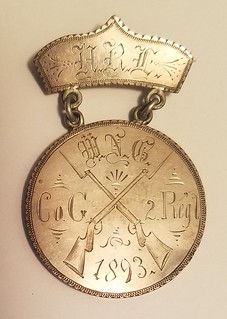 You collect for Historical Importance: You like love tokens that have a story, often rooted in history. These would be the trench art coins, names of important towns, important people, or political, just to name some obvious examples that come to mind. You enjoy holding history in your hands and the feel of finding and preserving something important.
You collect for Historical Importance: You like love tokens that have a story, often rooted in history. These would be the trench art coins, names of important towns, important people, or political, just to name some obvious examples that come to mind. You enjoy holding history in your hands and the feel of finding and preserving something important.
You collect based on Price: You set limits for what you will pay for specific types of love tokens. Like no more than ten dollars for an initialed dime or no more than thirty-five for a pictorial love token. Many newer collectors will collect by cost. They have found a new collectible but do not know exactly what it is worth or how much money they want to sink into the hobby. It takes time to grow into being a dedicated and serious collector. There is a comfort level with how much one wants to spend on the hobby. The longer you collect however, the more you will realize what is rare and what is worth spending more for. The drawback with price limits is having a mediocre collection because the odds are low that you will get something truly great at a bargain basement price. It could happen but not very often.
There is going to be some overlap in the types of collecting from category to category and some collectors may also find that they fit into more than one type of collector. Perhaps you even start as one type of collector and end as another as time goes by. There is probably some psychology that goes into collecting and addressing what motivates us to collect but I am just a collector and not a psychiatrist. I have known and spoken with many collectors over the years that have enabled me to try to define collecting here. I hope you enjoy some introspection as you think about where your collecting falls.
For more information on the Love Token Society, see:
http://lovetokensociety.com/
NUMISMAGRAM MEDAL SELECTIONS: MARCH 17, 2024
Numismagram's Jeremy Bostwick sent these three items from his most recent upload of new material to his site. This upload, occuring on the Ides of March, had a very macabre theme. For all of the new items, please visit https://www.numismagram.com/inventory. -Editor
102056 | GERMANY. Nürnberg. Copper Rechenpfennig Issued circa 1580-1610. (27mm, 5.43 g, 12h). By H. Laufer. DEN KVMPT DER DODT GIBT DEN LON, skeleton standing left within a graveyard and wielding a spear; in background, church to right // ARBEIT VND TVGENT MACHT EDEL, infant Christ standing slightly left, raising hand in benediction and holding orb. Neumann 32331; "Aspects of Death and Correlated Aspects of Life in Art, Epigram, and Poetry," p. 567. Choice Very Fine. Tan-brown surfaces, with a lighter nature on the higher points. A very rare and haunting type, and the first of the type that we have seen. $695.
Rechenpfennigen, German for "accounting pennies," are similar to other tokens or jetons that could serve reckoning, gaming, or even semi-numismatic functions. In particular, the rechenpfennigen were made famous by their various manufacturers in Nürnberg (Nuremberg) from the mid-late 16th century to the early 18th century, with a host of themes used as subject matter. These topics included history, mythology, contemporary political affairs, and even satire. Though many were intended as aids in accounting and bookkeeping (with an accounting board and these tokens taking the place of an abacus or sliderule), they were also useful in other functions, such as in the world of gaming—as poker chips—or in commerce and monetary transactions—as a substitute for harder currency.
To read the complete item description, see:
102056 | GERMANY. Nürnberg. Copper Rechenpfennig
(https://www.numismagram.com/product-page/102056)
102543 | BELGIUM. Luik (Liège). Chapter of St. Lambert's Cathedral bronze Méreau or Communion Token. Dated 1653. Used for the receiving of food during feast day celebrations (20mm, 4.46 g, 4h). ANNIVERSA?, skull and crossbones // ECCLESIÆ LEODI, crossbones between two flames. De Renesse pl. LXXI, 3. PCGS AU-50. Deep brown surfaces. Ever-popular type. $895.
St. Lambert served as the Bishop of Maastricht and later, Liège, where he is celebrated as a martyr and patron saint, having defended the fidelity of marriage and not succumbing to Merovingian politics. Though buried at Maastricht, his successor, St. Hubertus, had his relics removed and enshrined at Liège.
To read the complete item description, see:
102543 | BELGIUM. Luik (Liège). St. Lambert's Cathedral bronze Méreau.
(https://www.numismagram.com/product-page/102543)
102708 | CANADA. Mond Nickel Company nickel Medal. Issued 1925 for the 25th anniversary of the firm (44mm, 44.69 g, 12h). By P. Metcalfe. TUM PRIMUM CONGNITA PRAEPES SUBVOLAT (then for the first time a winged thing sprang aloft, –adapted from Ovid's Metamorphoses, Book XIV), Pan or impish, mischievous demon dancing left above flames, with bubbles ascending from his hands // THE MOND NICKEL COMPANY LIMITED / 1900•1925, stylized depiction of daffodils (Wales) and maple leaves (Canada), representing the two locations of the company's major interests. Edge: Plain. Choice Gem Mint State. Exceedingly brilliant and alluring, with cartwheel luster abounding throughout. $165.
To read the complete item description, see:
102708 | CANADA. Mond Nickel Company nickel Medal.
(https://www.numismagram.com/product-page/102708)
VILA RICA MOEDAS AUCTION 20
Vila Rica Moedas of São Paulo, Brazil will hold their next auction this week. Here's the announcement. Nice coins. For bibliophiles, there is a section of numismatic literature. -Editor
Vila Rica will hold its Auction 20 on March 19th and 20th. The auction is internet-only and split over two sessions. It will offer a vast range of Brazilian coins, from Colonial to Republican issues, and rare Literature, featuring:
-
 A selection of gold coins; among them we highlight the 1000 Réis 1726MMMM in exceptional condition, 1600 Réis 1767B UNC and 800 Réis 1728/7 M also in exceptional condition;
A selection of gold coins; among them we highlight the 1000 Réis 1726MMMM in exceptional condition, 1600 Réis 1767B UNC and 800 Réis 1728/7 M also in exceptional condition;
- Among the Silver coins, highlights include the rare 160 Réis 1813R with inverted reverse and 1821B with Bahia reverse (much rarer than the one with Rio reverse); 640 Réis 1822R, 2000 Réis 1863 very rare with inclined reverse;
- 200 Réis 1871 NGC MS64* featuring Proof Like surfaces - a piece with exceptional coinage quality produced with technology not available at the Brazilian Mint at the time. Possibly a presentation piece and as such extremely rare. Ask for the video so you can see how extraordinary the quality of this piece is;
- A very rare 10000 Réis 1840 assay in silver. Dom Pedro II Admiral on the obverse and the unapproved reverse with the monogram and imperial crown. The piece retains all of its original luster;
- We bring you some more rarities from the Cláudio Schroeder Library, including the famous Brazilian Gold Bars - Guilherme Guinle Collection, 1949. A very rare numismatic publication, this being from the Kurt Prober collection, with his notes reviewing, reclassifying, and correcting technical errors in the descriptions. The lot is accompanied by a set of letters between Guinle and Prober;
- Among the copper coins, two X Réis PPPP from 1694 and 1697 stand out, and an incredible set of 37 1/2 Réis de Minas from the Empire.
Some highlights of the sale follow:
Lot 21 - Brazil, 1000 Réis, 1726 MMMM. Gold. AI O234. AU. Rare denomination from the MMMM series without any sign of circulation and much remaining luster
Lot 22 - Brazil, 800 Réis, 1728/7 M. Gold. AI O257. AU. Beautiful example, with fully preserved details, and some luster. Like all fractions from the Minas Gerais Mint, a rare coin in any state of conservation. And, in the state of this being offered, it is even rarer
Lot 25 - Brazil, 1600 Réis, 1767B. Gold. AI O361. AU. Without any sign of circulation. Extremely rare in this condition
Lot 75 - Brazil, 160 Réis, 1813R. Silver. AI P406a. Under. INVERTED Reverse - RARE. Struck over a 150 Réis "Jota". And above all, beautiful
Lot 81 - Brazil, 160 Réis, 1821B. Silver. AI P458. VF/EF. Bahia reverse (much rarer than Rio's on this date). Struck over 150 Réis "Jota" obverse on reverse. Traces of letters below the upper trapezoid and SUBQ. Very rare!
Lot 96 - Brazil, 640 Réis, 1822R. Silver. AI P475; Lup 1A. AU. Light cleaning but still very attractive. Rare date!
Lot 194 - Brazil, 2000 Réis, 1863. Silver. AI P622. AU. Slanted Reverse – RARE
Lot 486 - Brazil, Assay - 10000 Réis, 1840. Silver. AI E139; Bentes E21.03. UNC. Very rare silver assay with the portrait of Dom Pedro II Admiral on the obverse and the unapproved reverse with the monogram and the imperial crown. The piece retains all of its original luster. Few and very light hairlines, visible only with a magnifying glass, which in no way detract from the attractiveness of this very rare assay
Lot 487 - Brazil, 200 Réis, 1871. Cupro-Nickel. AI V016. NGC MS64*. Proof-Like Surfaces. A piece with exceptional striking quality produced with technology not available at the Brazilian Mint at the time. Possibly a presentation piece, and which will require further research
Lot 340 - Brasil, X Réis, 1697PPPP. Copper. AI C006. VF. Rare
Lot 411 - Brasil, 37 1/2 Réis, 1828M. Copper. AI C730. AU. RARE
Lot 452 - Literature, Guilherme Guinle, Brazilian Gold Bars - Guilherme Guinle Collection, 1949. Very rare numismatic publication with an edition of 30 copies, all numbered and autographed by the author. Copy number 19. Former Kurt Prober collection, and this copy has his personal notes, reviewing, reclassifying, and correcting technical description errors. Two spectacular letters are attached to the volume, the first being a letter from Guinle on letterhead, in which he responds to Prober's request about the book; the second is a letter from Prober, recording receipt of the book, thanking him and making observations. Finally, dedication from Prober to Cláudio Schroeder. The lot comes with Prober ticket with ferry timetable to Paquetá Island (where Prober used to live) and address in the city of Rio de Janeiro. A jewel in every sense of Brazilian numismatic bibliophilia. The set is packaged inside a letterhead envelope from a Masonic lodge addressed to Prober dated 07/26/2000. Spectacular and rare
The auction will take place on March 19th and 20th. Registration for bidding can be done at https://leiloes.vilaricamoedas.com/ . If you need assistance, please feel free to contact either David or Hilton through the email info@vilaricamoedas.com and they will be happy to assist you with registration.
Vila Rica Moedas (www.vilaricamoedas.com) is a Numismatic company based in São Paulo, Brazil, and it is run by its two partners David André Levy and Hilton Lúcio, both authors of reference catalogs and accomplished numismatists.
DAVISSONS AUCTION 43 SCOTLAND HIGHLIGHTS
Allan Davisson wrote this overview of the Leland Scott Collection of the Coins of Scotland in his firm's Auction 43, which closes on Wednesday, March 20th 2024. -Editor
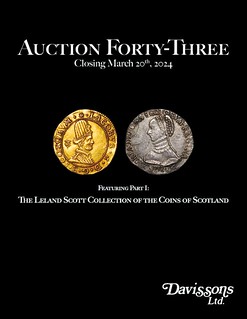 The Leland Scott Collection of the Coins of Scotland presents the first high quality, well-pedigreed collection of Scottish coins to come to the market since the LaRiviere sale in 2006. It anchors our 2024 major annual sale of some of the best coins we have come across in the past year.
The Leland Scott Collection of the Coins of Scotland presents the first high quality, well-pedigreed collection of Scottish coins to come to the market since the LaRiviere sale in 2006. It anchors our 2024 major annual sale of some of the best coins we have come across in the past year.
This beautiful and historic series contains a fascinating array of designs that chronicle the tumultuous winds of Scottish history, and presents a major departure in style and beauty from both the English and Irish coinage series.
Many of the coins in the Scott collection have important pedigrees. The Scottish series is small enough that high quality examples tend to carry their cachet from one important collection to another. There have not been enough high grade Scottish pieces offered since LaRiviere to be able to cite equivalents for many of the pieces. To establish estimates, I have relied on years of focus on Scottish material, drawing on personally marked catalogs from attending major sales, paying attention to the market, and helping to build some major collections, including this one. Estimates are at the conservative end of the value range.
This collection will be offered over three sales: A major introduction to the collection with some of the most important pieces in the series is featured in this auction. Our early June sale will focus on some of the less valuable coins in the collection. The grading standards for high quality for the rare pieces hold for the less valuable pieces in the series as well.
Then, early in the fall we will offer the last portion of the collection, again featuring some of the major rarities of the series—both gold and silver.
I myself have been enamored of the coinage of Scotland since I first began collecting British coins while still a student. Attached is a link to an article I wrote, inspired by this collection and specifically for this catalog—a brief overview of coinage design in Scotland from the start to the reign of Mary Stuart.
I hope you enjoy looking through this collection as much as I have presenting it. This collection provides a rare opportunity to represent or add to one's own collection beautiful coins from this amazing historic and artistic series that straddles the medieval era and the Renaissance. I considered it an honor to be able to work with this marvelous collection.
To browse the online and print catalogs, see:
https://davcoin.com/sale/Printed%20Auction%2043
https://davcoin.com/pdf-viewer/49589
To read the earlier E-Sylum article, see:
DAVISSONS AUCTION 43 ANNOUNCED
(https://www.coinbooks.org/v27/esylum_v27n06a19.html)
NOTES ON SCOTTISH COIN DESIGN
Here's Allan Davisson's article on Scottish coin design. Davisson's Auction 43 of the Leland Scott Collection of the Coins of Scotland closes this week. -Editor
A few notes on Scottish coin design from David to Mary
Scottish coinage began during the Anarchy and Stephen's reign (1135-1154). After the death of Henry I in 1135, Stephen of Blois, despite an oath to Matilda, Henry I's daughter, seized the English throne. The next year, David I moved south to support Matilda, his niece. Capturing the mint at Carlisle resulted in the first coinage that is considered Scottish.
Malcolm, David's twelve-year-old grandson came to the throne in 1153 but coinage continued in the somewhat irregular pattern that had marked David's reign, not unlike the irregular coinage of the Anarchy in England.
Around 1170, about five years into his reign and not long after the introduction of the short cross penny in England, William I began the crescent and pellet
coinage that prevailed until a voided short cross series began in 1195. It was not until the reign of Alexander III (1249-1286) that this high-quality Scottish coinage was produced in large enough quantities that substantial quantities of coinage of the era survived and the neatly produced pennies of Alexander III matched the high quality of English coinage in use at the time.
David II's coinage was influenced by English coinage under Edward III. Though his effort at a gold noble proved short-lived (only four examples are known), his introduction of the groat, a four-penny piece, paralleled the English series and was a dominant part of Scottish coinage until the reign of James V. Similar in terms of overall design to the English groat until the reign of James III, the Scottish groat took an unusual artistic turn in 1471 with a realistic Renaissance image of the young king replacing the stylized facing medieval bust that was the standard at the time. This was an era of humanistic revival in the arts in Italy and realistic portraiture was one of the most visible signs of this changed world view. This reawakening made its way to Scotland and influenced coinage there well before this new spirit influenced coin artistry in the rest of Britain.
A more regular gold coinage in Scotland came during the reign of Robert III (1390-1406) with the gold lion that reflected the gold ecu d'or of French king Charles VI. (Note lot 21 in this sale.) From there, the gold issues of Scotland continue to show style and imagination—riders, unicorns, bonnet pieces, hat pieces and, ultimately the beautiful coins of Mary and the varied gold issues of James VI.
The Italian and, later, French influences on Scottish coinage peaked during the reign of Mary. John Achesoun was the master of the mint and the 1562-1563 testoon of Mary was produced under his leadership with dies from the French artist Antoine Brucher at the Paris mint. The earlier portrait testoon of Mary as she was nearing eleven years old had been his work as well.
To read the complete article, see:
A Style of Their Own
(https://davcoin.com/news-item/style-their-own)
To browse the online and print catalogs, see:
https://davcoin.com/sale/Printed%20Auction%2043
https://davcoin.com/pdf-viewer/49589
To read the earlier E-Sylum article, see:
DAVISSONS AUCTION 43 ANNOUNCED
(https://www.coinbooks.org/v27/esylum_v27n06a19.html)
KUENKER AUCTIONS 403-405
Here's the first part of two parts of the press release with a preview of the Künker Spring Auction Sales 403-406. -Editor
Popes, Mainz, Regensburg and Löwenstein: Special Collections at Künker
Once again, Künker presents numerous special collections at their Spring Auction Sales. You can look forward to papal coins and medals, issues of the Mainz mint, Regensburg as well as Löwenstein-Wertheim. Moreover, a plethora of world coins and medals is on offer with a focal point on German issues.
As many as four catalogs with coins and medals from medieval and modern times alone will be presented in Künker's Spring Auction Sales, taking place from 18 to 22 March 2024 in Osnabrück. Auction 403 contains papal coins and medals from the estate of a south-west German entrepreneur; auction 404 offers the second part of Mainz coins and medals from the Prof. Dr. Eckhart Pick Collection; auction 405 deals with an important special collection of coins from the bishopric and the imperial city of Regensburg; and general catalog 406 does not only include world coins and medals but also a special collection with issues of the counts and princes of Löwenstein-Wertheim. Moreover, an extensive selection of Habsburg talers and ducats is on offer.
In short: 3,240 lots with a total estimate of 4.3m euros eagerly await their new owners. There really is something on offer for everyone. Estimates start in the low two-digit range, although this preview will obviously focus on the more expensive pieces. Look forward to a rich offer of exquisite world issues!
Auction 403: Coins and Medals of the Popes – The Important Special Collection of a South-West German Entrepreneur
Papal coinage is one of the most fascinating numismatic fields out there. This is also due to the fact that these coins have been coveted souvenirs for a very long time, and were added rather early to prestigious coin collections of the European nobility. Young men who visited Rome as part of their grand tour took them home as they were popular souvenirs and easy to transport.
Therefore, since the late Renaissance, it has been a great business for the papal mint to produce coins and medals that will never enter circulation. Their attractive motifs featuring ecclesiastical ceremonies, buildings, allegories or biblical scenes made these issues the predecessors of modern commemorative coins.
In this regard, you should take a careful look at the extensive catalog for auction 403 with the important special collection of a south-west German entrepreneur. It is worth it! Especially if you closely examine every detail of the carefully designed motifs.
But, of course, auction 403 also contains significantly older pieces. The collector tried to purchase at least one coin of every pope, an ambitious endeavor that was of course doomed to failure regarding late antiquity and the Middle Ages. However, starting with Clement VI (1342-1352) we can find more and more popes; and starting with Pope Martin V (1417-1431) the collection is almost complete and also contains rare sede vacante issues. Those who love the city of Rome and enjoy extraordinary motifs will certainly be tempted to collect pieces of this highly interesting field themselves after admiring the beautiful images in this catalog.
No. 1340: Sixtus V, 1585-1590. Scudo d'oro, 1586, Ancona. Very rare. Extremely fine. Estimate: 10,000 euros
No. 1353: Gregory XV, 1621-1623. Scudo d'argento, 1621, Ferrara. Rare. Very fine +. Estimate: 4,000 euros
No. 1403: Innocent XI, 1676-1689. Quadrupla, AN II (1676/77), Rome. Very rare. Extremely fine. Estimate: 30,000 euros
No. 1515: Clement XI, 1700-1721. Testone, AN V (1704/05), Rome. Very rare. Extremely fine. Estimate: 4,000 euros
No. 1624: Pius VI, 1775-1799. 5 zecchini, AN XIII (1787), Bologna. Extremely fine to FDC. Estimate: 12,500 euros
No. 1754: Pius IX, 1846-1878. Gold medal, AN XXIII (1868). Rv. Loggia Pia. Very rare. Extremely fine to FDC. Estimate: 3,000 euros
Auction 404: Mainz Coins and Medals from the Pick Collection – Part II
In 2011, the internationally acclaimed specialist in Mainz coinage Prof. Dr. Pick auctioned off his extensive Mainz collection at Dr. Busso Peus Nachf. He decided to make public his comprehensive holdings as well as the results of his numismatic and historical research. However, he experienced what many collectors experienced before him: after the sale of his collection, he immediately started to build up another one, which will be offered on 19 March 2024 as part II of the Pick Collection in Künker's auction 404.
Born in 1941, Prof. Dr. Eckhart Pick is one of the most renowned German collectors. Having earned his doctorate in the legal department of the university, he went on to teach at the Johannes Gutenberg University in Mainz before he became a full-time politician. Representing the Social Democratic Party, he was a member of the state parliament of Rhineland-Palatinate from 1985 to 1987. From 1987 to 2002, he helped shape German reunification as a member of Germany's federal parliament. And as Parliamentary State Secretary of the Federal Minister of Justice Prof. Dr. Herta Däubler-Gmelin, he influenced Germany's legal landscape from 1998 to 2002.
As a collector, Prof. Pick was committed to his home town of Mainz, one of the major centers of German history. The fate of the Holy Roman Empire was often determined in this very place. Afterall, the Archbishop of Mainz was also the Archchancellor of the German part of the empire. In this position, he was in charge of the election process that determined the new ruler after the king or emperor had died. For this purpose, the archchancellor convened the electors, determined where and when the election was to take place and thus played a crucial role in this process before the Golden Bull of 1356 was adopted.
In his second collection, Prof. Pick mainly focused on the coins that were missing in his first collection. He therefore covered both the Roman mint with a piece by the usurper Laelian, who declared himself emperor at Moguntiacum, as Mainz was called in Roman times, as well as Mainz issues of the Merovingians and Carolingians. The major focal point is on the Archbishopric of Mainz with a series of extremely rare coins and medals of the archbishops. Moreover, connoisseurs can look forward to issues of the city of Mainz, medals relating to Johannes Gutenberg as well as Erfurt issues, a town that belonged of the Electorate of Mainz. It is to be expected that this catalog of Mainz coins and medals presenting the second part of the Pick Collection will also become a standard reference work.
No. 2013: Carolingians. Louis the German, 843-876. Pfennig, Mainz. Extremely rare. Very fine. Estimate: 5,000 euros
No. 2130: Adolf I of Nassau, 1373-1390. Gold gulden n.d. (1373-1374), no indication of the mint (Bingen). Very rare variety. Extremely fine. Estimate: 5,000 euros
No. 2286: Daniel Brendel von Homburg, 1555-1582. 1/2 reichstaler, 1567, Mainz. Half bettlertaler
(so-called beggar's taler). Very rare. Very fine to extremely fine. Estimate: 5,000 euros
No. 2313: Georg Friedrich von Greiffenclau zu Vollrads. Broad double reichstaler, 1629, Mainz. Very rare. About extremely fine. Estimate: 20,000 euros
No. 2471: Franz Ludwig von Neuburg, 1729-1732. 6 ducats, 1730, unsigned, Vienna. Extremely rare. Very fine to extremely fine. Estimate: 35,000 euros
No. 2474: Philipp Karl von Eltz-Kempenich, 1732-1743. Gold medal of 25 ducats, 1740. Extremely rare. Extremely fine to FDC. Estimate: 75,000 euros
No. 2549: City of Mainz. Gustav II Adolph, 1631-1632. Ducat, 1631. Very rare. About extremely fine. Estimate: 10,000 euros
Auction 405: Regensburg
321 lots with many spectacular issues from the imperial city of Regensburg will be auctioned on 20 March 2024 between 10 a.m. and 1 p.m. The collection mainly focuses on early modern issues, i.e., those of Emperor Maximilian I (1508-1519) – whom historians like to refer to as the last knight – up to pieces from the worldly Principality of Regensburg, which was created by the Imperial Recess of 1803 before the tradition-honored trading city was annexed to the Kingdom of Bavaria in 1810.
The focal point of the collection is on rare ducats and talers, some of which depict fascinating city views that are incredibly rich in detail. This abundant selection of representative coins should not come as a surprise. After all, these pieces were not used for trade purposes but for something else. Regensburg had become the venue of the Perpetual Diet in 1663, a place where envoys from the entire Holy Roman Empire aligned their policies. Leading European powers had high-paid representatives there that often used magnificent coins as diplomatic gifts. At a time when mint masters had the right to transform the gold and silver of private individuals into coins, countless issues were created that catered to the diplomats' needs.
That is why there are so many beautiful issues from Regensburg, which are sought after by collectors all over the world. They can look forward to a selection of the most beautiful coins from the city on the Danube River.
No. 3061: Regensburg. Broad triple gulden taler, 1595. With the title of Emperor Rudolf II, 1576-1612. Extremely rare. Late strike, probably around 1750. Very fine to extremely fine. Estimate: 10,000 euros
No. 3101: Regensburg. Ducat, 1633, commemorating the capture of Regensburg by Swedish-Protestant troops and Duke Bernhard of Saxe Weimar. Extremely rare. Extremely fine. Estimate: 10,000 euros
No. 3152: Regensburg. Double reichstaler n.d. (around 1700). With the title of Emperor Leopold I, 1658-1705. From the Julius Jenke Coll., Beckenbauer auction 1 (1961), No. 32. Extremely rare. Extremely fine. Estimate: 10,000 euros
No. 3287: Regensburg. Konventionstaler, 1766. With the title of Joseph II, 1765-1790. From the Julius Jenke Coll., Beckenbauer auction 1 (1961), No. 3287. Extremely rare. Extremely fine to FDC. Estimate: 10,000 euros
No. 3320: Principality of Regensburg. Carl Theodor von Dalberg, 1804-1810. Ducat, 1809. Very rare. Extremely fine. Estimate: 20,000 euros
To order a catalog contact Künker, Nobbenburger Straße 4a, 49076 Osnabrück; phone: +49 541 / 962020; fax: +49 541 / 9620222; or via e-mail: service@kuenker.de. You can access the auction catalogs online at www.kuenker.de. If you want to submit your bid from your computer at home, please remember to register for this service in good time.
KUENKER AUCTION 406
Here's the second and final part of the press release with a preview of the Künker Spring Auction Sales 403-406. -Editor
Auction 406: Issues from Medieval and Modern Times
More than 1,800 lots with coins and medals from medieval and modern times are offered at Künker's auction 406. No matter what you are interested in, browsing through this catalog is a must. Be it world coins, medieval rarities, issues from the German States, the German Empire, ducats or talers. This catalog contains countless interesting offers, including several special collections.
No. 3524: France. Philippe VI, 1328-1350. Ange d'or n.d. (1341). Very rare. About extremely fine. Estimate: 15,000 euros
No. 3563: Great Britain. George II, 1727-1760. Gold medal of 25 ducats, 1732, by E. Hannibal. Very rare. With traces of mounting and re-worked fields. Very fine. Estimate: 15,000 euros
No. 3672: Czechoslovakia. Ducat, 1923, Kremnica. Only 1000 specimens minted. NGC MS62. Extremely fine +. Estimate: 10,000 euros
No. 4687: France / Carolingians. Charlemagne, 768-814. Denarius, 813/4 or a little later, Aachen. One of two known specimens, the only one in private hands. About very fine. Estimate: 20,000 euros The portrait denarii of Charlemagne with the title of emperor IMP(erator) AVG(ustus) instead of the usual REX Fr(ancorum) are among the great rarities of medieval numismatics.
No. 4815: Russia. Alexander II, 1855-1881. Pattern of the 1860 ruble, St. Petersburg. Extremely rare. About extremely fine. Estimate: 50,000 euros
No. 4838: Switzerland / Sion, Bishopric. Nikolaus Schiner, 1496-1499. Guldiner, 1498. Extremely rare. Very fine +. Estimate: 20,000 euros
Talers and Ducats of the Habsburgs in Auction 406
Let us begin with the large selection of Habsburg issues that will come under the hammer in auction 406. A total of 340 lots perfectly illustrate that there are still fields of numismatic interest that allow collectors to build up large and important collections with comparably little money. The estimates for ducats of attractive quality start as low as at 500 euros and even the rarities are estimated at around 1,500 euros (of course, the hammer price might be higher). The estimates of the talers are even lower and start at 300 euros – even regarding extremely fine specimens!
Of course, this selection also includes great rarities such as the first 1486 guldiner, spectacular multiple ducats such as a quintuple 1636 ducat minted by Ferdinand II in Prague as well as a ten-fold ducat created in 1695 for Leopold I at the Cluj-Napoca (Klausenburg) mint for Transylvania. This part of the catalog does not only present coins of the Habsburg imperial dynasty; connoisseurs will also find a rich selection of issues of the Austrian princes.
No. 3815: Rudolf II, 1576-1612. Ducat, 1593, Kremnica. About FDC. Estimate: 1,500 euros
No. 3821: Ferdinand II, 1592-1618-1637. 5 ducats, 1636, Prague. Very rare. Very fine to extremely fine. Estimate: 25,000 euros
No. 3827: Leopold I, 1657-1705. 10 ducats, 1695, Cluj-Napoca (Klausenburg) on behalf of Transylvania. Very rare. Minimal traces of mounting. Very fine. Estimate: 30,000 euros
No. 3834: Charles VI, 1711-1740. Ducat, 1740, Nagybanya (Frauenbach). Rare. Extremely fine. Estimate: 1,500 euros
No. 3848: Maria Theresa, 1740-1780. Ducat, 1761, Karlsburg. Extremely fine to FDC. Estimate: 1,500 euros
No. 4446: Tyrol. Archduke Sigismund called ‘rich in coins', 1446-1496. Guldiner, 1486, Hall. Very rare. Very fine to extremely fine. Estimate: 7,500 euros
No. 4495: Ferdinand II, 1592-1618-1637. Reichstaler, 1627, Graz. About FDC. Estimate: 600 euros
No. 4535: Leopold I, 1657-1705. 1658 reichstaler, Vienna. Very rare. About extremely fine. Estimate: 3,000 euros
No. 4675: Austrian princes / Windischgrätz. Leopold Victor Johann, 1727-1746. Reichstaler, 1732, Vienna. Rare. Extremely fine / Extremely fine to FDC. Estimate: 2,000 euros
Rarities from Germany
As always, Künker's focus is on coins from the German States. Excellent quality, great rarities, attractive provenances – no matter what you value most, you will find the perfect coin in Künker's upcoming auction sales.
No. 3949: Bavaria. Ludwig I, 1825-1848. Off-metal strike in gold from the dies of the 1845 double gulden. From the Coenen Coll. and the Ferrari Coll. Extremely rare. NGC MS63+. FDC. Estimate: 15,000 euros
No. 4028: Münster, Bishopric. Christoph Bernhard von Galen, 1650-1678. Gold gulden, 1678, by Münster to commemorate his passing. Extremely rare. Very fine. Estimate: 12,500 euros
No. 4054: Saxony. Frederick Augustus I, 1694-1733. 2 ducats, 1695, Dresden. Extremely rare. Extremely fine. Estimate: 20,000 euros
No. 4144: Brunswick-Wolfenbüttel. Julius, 1568-1589. Löser of 10 reichstalers, 1574, Heinrichstadt, with a weight of 9 reichstalers. From Leu auction 73 (1998), No. 738. Extremely rare. Extremely fine. Estimate: 75,000 euros
No. 4309: Nuremberg. 1519 bronze cast medal (engraved) by H. Schwarz commemorating the patrician and mayor of Nuremberg Martin Tucher. From a princely estate. Extremely rare. Original cast. Extremely fine. Estimate: 7,500 euros
No. 4409: Silesia. Liegnitz-Brieg. Johann Christian and Georg Rudolf, 1602-1621. Double reichstaler, 1609, Reichenstein. Very rare. Very fine. Estimate: 10,000 euros
Special Collection Löwenstein-Wertheim in Auction 406
The early modern German States consisted of a variety of territories. Some of them were so tiny that their rulers were often mocked abroad. The rulers of Löwenstein-Wertheim were probably also mocked as their principality was particularly small. However, the rulers of such territories still perceived themselves as autonomous princes with high ambitions. How powerful they felt is also reflected by their sophisticated coins. The special collection Löwenstein-Wertheim offered by Künker is a perfect example of this.
In 1597, Ludwig III of Löwenstein-Wertheim adopted a law that obliged his successors to divide their inheritance into equal parts. This resulted in his territory being more and more fragmented, and numerous successors claimed the privilege of minting coins. This historical situation is highly fascinating to collectors. Most of the coins minted by the counts and later the princes of Löwenstein-Wertheim are extremely rare and show many different, often highly interesting depictions.
No. 4018: Löwenstein-Wertheim-Rochefort. Karl Thomas, 1735-1789. Ducat, 1754, Nuremberg. Very rare. Extremely fine. Estimate: 7,500 euros
No. 4239: Löwenstein-Wertheim-Virneburg. Eucharius Kasimir, 1681-1698. Reichstaler, 1697, Wertheim. Very rare. Extremely fine. Estimate: 1,500 euros
No. 4242: Löwenstein-Wertheim-Virneburg. Johann Ludwig Volrad, 1730-1790. Konventionstaler, 1769, Wertheim. Rare, especially in this quality. Extremely fine. Estimate: 2,000 euros
No. 4253: Löwenstein-Wertheim-Rochefort. Maximilian Karl, 1662-1718. Reichstaler, 1711, Wertheim. Very rare. Extremely fine. Estimate: 5,000 euros
Coins of the German Empire (Auction 406)
Let us round off this preview of the upcoming Künker auction sale of modern coins with a glance at the section of issues from the German Empire. As usual, there is a rich offer of extremely rare gold and silver coins of outstanding quality. We present a few examples.
No. 4946: German Empire. Württemberg. William II, 1891-1918. 3 marks, 1916. Anniversary of the reign. Rare. Frosted obverse. Proof. Estimate: 5,000 euros
No. 5074: German Empire. Mecklenburg-Strelitz. Frederick William, 1860-1904. 10 marks, 1873. Very rare. About extremely fine. Estimate: 35,000 euros
No. 5172: German New Guinea. 10 New Guinean marks, 1895. Only 2000 specimens minted. Extremely fine to FDC. Estimate: 40,000 euros
No. 5282: German Empire. Bavaria. Ludwig III, 1913-1918. Pattern of 20 marks, 1914. From the Coenen Coll. Very rare. About FDC. Estimate: 10,000 euros
And do not forget that after the auction is before the auction! On 26 March 2024, Künker's eLive Premium Auction 407 starts at 10 a.m. featuring coins of Emperor Franz Joseph from the collection of Heinz Tursky, who passed away in 2023.
To order a catalog contact Künker, Nobbenburger Straße 4a, 49076 Osnabrück; phone: +49 541 / 962020; fax: +49 541 / 9620222; or via e-mail: service@kuenker.de. You can access the auction catalogs online at www.kuenker.de. If you want to submit your bid from your computer at home, please remember to register for this service in good time.
STACKS BOWERS OFFERS NINI TERRACOTTA PORTRAITS
The Richard Margolis collection of Terracotta Portrait Medallions by Jean-Baptiste Nini will be offered by Stack's Bowers in their Spring 2024 Whitman Expo Auction. Here is a selection of highlights. Amazing material. -Editor
of Terracotta Portrait Medallions
by Jean-Baptiste Nini
In American numismatic auctions, Nini is well known for his 1777 and 1779 terracotta portrait medallions of Benjamin Franklin. Richard Margolis wrote an in-depth study of this small series titled Benjamin Franklin in Terra Cotta, published in 2015. Upon consignment, we anticipated a collection of the Franklin portraits, but were delighted to see that Margolis had collected Nini's works more broadly. Including a nice selection of Franklin medallions, we will present more than two-dozen Nini profiles dating from the 1760s to 1785. As far as we are aware, this is the first presentation of this speciality in an American numismatic sale. A selection of highlights is featured here.
1769 Portrait of Suzanne-Elisabeth-Françoise de Jarente de La Reynière
To read the complete lot description, see:
1769 Portrait Medallion of Suzanne-Elisabeth-Françoise de Jarente de La Reynière, to right. By Jean-Baptiste Nini. Baiardi-Sibille 71, S...
(https://auctions.stacksbowers.com/lots/view/3-18F76N/1769-portrait-medallion-of-suzanne-elisabeth-franoise-de-jarente-de-la-reynire-to-right-by-jean-baptiste-nini-baiardi-sibille-71-s)
1770 Portrait of King Louis XV of France
To read the complete lot description, see:
1770 Portrait Medallion of Louis XV, King of France, to left. By Jean-Baptiste Nini. Baiardi-Sibille 75, Storelli-XXXIX, Villers-23. Ter...
(https://auctions.stacksbowers.com/lots/view/3-18F76T/1770-portrait-medallion-of-louis-xv-king-of-france-to-left-by-jean-baptiste-nini-baiardi-sibille-75-storelli-xxxix-villers-23-ter)
1774 Portrait of Marie Antoinette, Queen of France
To read the complete lot description, see:
1774 Portrait Medallion of Marie Antoinette, Queen of France, to left. By Jean-Baptiste Nini. Baiardi-Sibille 83, Storelli-LIV, Villers-...
(https://auctions.stacksbowers.com/lots/view/3-18F775/1774-portrait-medallion-of-marie-antoinette-queen-of-france-to-left-by-jean-baptiste-nini-baiardi-sibille-83-storelli-liv-villers-)
Superb Benjamin Franklin in Spectacles Portrait by Èmile Balon, after Nini
To read the complete lot description, see:
Undated (circa 1890s) Benjamin Franklin Portrait Medallion. Fur Cap with Spectacles. By Émile Balon, after Jean-Baptiste Nini. Margolis-...
(https://auctions.stacksbowers.com/lots/view/3-18F77U/undated-circa-1890s-benjamin-franklin-portrait-medallion-fur-cap-with-spectacles-by-mile-balon-after-jean-baptiste-nini-margolis-)
Extremely Rare 1777 Small Module Franklin Medallion in High Relief
To read the complete lot description, see:
1777 B. Franklin Américain Portrait Medallion. Fur Cap without Spectacles. By Jean-Baptiste Nini. Margolis-10, Baiardi-Sibille 94, Green...
(https://auctions.stacksbowers.com/lots/view/3-18F788/1777-b-franklin-amricain-portrait-medallion-fur-cap-without-spectacles-by-jean-baptiste-nini-margolis-10-baiardi-sibille-94-green)
Outstanding and Rare 1779 Grand Module Franklin Medallion
To read the complete lot description, see:
1778 Benjamin Franklin Portrait Medallion. Bare Head Left; French Legend. By Jean-Baptiste Nini. Margolis-19, Baiardi-Sibille 95, Greens...
(https://auctions.stacksbowers.com/lots/view/3-18F79G/1778-benjamin-franklin-portrait-medallion-bare-head-left-french-legend-by-jean-baptiste-nini-margolis-19-baiardi-sibille-95-greens)
1780 Portrait of King Louis XVI of France
To read the complete lot description, see:
1780 Portrait Medallion of Louis XVI, King of France, to right. By Jean-Baptiste Nini. Baiardi-Sibille 100, Storelli-LXX, Villers-36. Terracotta.
(https://auctions.stacksbowers.com/lots/view/3-18F7AE/1780-portrait-medallion-of-louis-xvi-king-of-france-to-right-by-jean-baptiste-nini-baiardi-sibille-100-storelli-lxx-villers-36-te)
VANCOUVER ISLAND GLEN GREEN'S ORCA COIN
As noted before, local publications can be a good source of information about coin designers not found elsewhere. Here's an article about the artist behind the Royal Canadian Mint's new Orca coin. Nice design! -Editor
A new Royal Canadia Mint silver coin features the artwork of a Vancouver Island-based artist.
The coins, a part of the This is Canada collection, depict various species that can be found across the country. This year's theme is Wondrous Waters and one of the collectable coins features a pod of orcas.
Created by artist Glen Green, the orcas are travelling in the water near a rocky island. Mint adds in the background that large forests and mountains line the shore.
As Campbell River resident, Green says he jumped at the opportunity to make an orca picture as it is an icon of the area.
The coins are the first in a four-part series from Mint, made on 99.99 per cent silver coins.
Green is well known for his paintings of NHL athletes and has done other coin designs for Mint including for the 2010 Olympics.
For an artist, this is what you call a great gig,
said Green. Once you do one coin and they like it, it seems like you're on their list. The challenge of these coins is really fun.
For more information, or to order, see:
Pure Silver Coin – This Is Canada: Wondrous Waters - Pacific Coast
(https://www.mint.ca/en/shop/coins/2024/pure-silver-coin-this-is-canada-wondrous-waters-pacific-coast)
To read the complete article, see:
Vancouver Island artist's orca design found on new silver Mint coin
(https://www.mycomoxvalleynow.com/97702/news/island-coast/vancouver-island-artists-orca-design-found-on-new-silver-mint-coin/)
REPLICA PINE TREE SHILLINGS AT CSNS
Pewter replicas of the Pine Tree Shilling will be struck at the upcoming Central States Numismatic Society convention. Here's the press release. -Editor
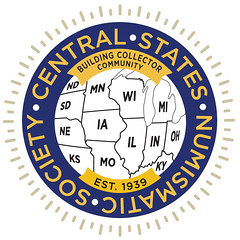 Visitors can see $100 million of historic money and buy and sell rare coins, paper money, and gold and silver bullion with hundreds of professional dealers from the Midwest and across the country at the Central States Numismatic Society convention, May 2-4, 2024. The annual show will again be held at the Renaissance Schaumburg Convention Center, 1551 North Thoreau Drive, in the Chicago suburb of Schaumburg, Illinois.
Visitors can see $100 million of historic money and buy and sell rare coins, paper money, and gold and silver bullion with hundreds of professional dealers from the Midwest and across the country at the Central States Numismatic Society convention, May 2-4, 2024. The annual show will again be held at the Renaissance Schaumburg Convention Center, 1551 North Thoreau Drive, in the Chicago suburb of Schaumburg, Illinois.
At this year's convention, you can watch souvenir replica coins struck on a hand-operated, century-old rolling mill press,
said Central States President Mitch Ernst.
Specially crafted pewter replicas of the 1652-dated Pine Tree Shilling, one of Colonial America's most famous rare coins, will be struck during the convention and available for $1 each while supplies last. A limited number also will be struck in .999 fine silver by engraver Joe Paonessa of The Root River Mint in Racine, Wisconsin with their price based in connection with the spot price of the precious metal.
Using a Samuel Crocker rolling mill that was originally built in the early 1900s and now modified to become a rocker press, I'll be making 500 replicas in pewter, 100 in silver, and one has been made in .900 gold. The souvenir's design is similar to the famous 1652 Pine Tree Shillings but also with the wording 2024 CENTRAL STATES NUMISMATIC SOCIETY on the obverse,
explained Paonessa, a member of the Racine Coin Club and a machinist who restored the vintage press and engraved dies for the CSNS souvenir replicas.
Heritage Auctions (www.HA.com) will conduct a public auction in conjunction with the CSNS convention. There also will be educational seminars and special exhibits, including rare paper money from the Higgens Museum of National Banknotes (www.TheHigginsMuseum.org) as part of the CSNS State Showcase salute to Iowa, one of the 13 states in our organization's region,
said Ernst.
To honor the 85th anniversary of CSNS, a limited quantity of a special edition of the new 2025 Red Book,
the annual A Guide Book of United States Coins, will be available for sale at the CSNS table. Editor Jeff C. Garrett will be autographing copies of the book while supplies last at 3 pm on Friday, May 3.
Public hours are Thursday and Friday, May 2 and 3, from 10:00 am to 6:00 pm, and on Saturday, May 4, from 9:30 am to 4:00 pm.
Admission at the door is $15 for adults, $30 for a three-day pass, and there is free admission daily for anyone 17 and younger. Advance tickets can be purchased online at www.CSNS.org/convention. Parking at the convention center is free.
Information about the Central States Numismatic Society convention is available on the convention website www.CSNS.org/convention, or by contacting Convention Manager Cindy Wibker by phone at 407-221-8737 or by email at convention@CSNS.org.
2024 ANIMALS IN WAR & PEACE CEREMONY
Here's the post-event press release for the 2024 Animals in War & Peace Ceremony at the U.S. Capitol. -Editor
Honored Seven Remarkable Canine Heroes
 Distinguished Members of Congress participated in the recent Fourth Annual Animals in War & Peace Ceremony to celebrate seven extraordinary canine heroes in recognition of their courage and sacrifice to the United States and their significant contributions in both times of war and peace.
Distinguished Members of Congress participated in the recent Fourth Annual Animals in War & Peace Ceremony to celebrate seven extraordinary canine heroes in recognition of their courage and sacrifice to the United States and their significant contributions in both times of war and peace.
The Animals in War & Peace Medal of Bravery recognizes animals that have served in past conflicts and current working or retired military canines representing various branches of U.S. military services, service animals, and First Responders. The 2024 Animals in War & Peace Medal of Bravery recipients:
K9 Yoda (MOB #18) – U.S. Border Patrol Tactical Unit BORTAC, Detroit Sector
Presented by Congressman Jamie Raskin
K9 Endo and K9 Ax (MOB#19) – Volusia, FL Sheriff's Office
Presented by Congresswoman Julia Brownley and Congressman Gus Bilirakis
K9 Kitt 823K (MOB #17) – Braintree, MA Police Department (Posthumously)
Presented by Congressman Jamie Raskin
The Animals in War & Peace Distinguished Service Medal recognizes animals for their exceptionally meritorious service to the United States in roles of great responsibility. The 2024 Animals in War & Peace Distinguished Service Medal recipients:
K9 Cody (DSM #5) – U.S. Embassy-Baghdad / American K9 Interdiction, VA
Presented by Congressman Michael Quigley
K9 Bane (DSM #6) – St. Francis Police Department/FBI Milwaukee SWAT, WI
Presented by Congressman Bryan Steil
K9 Sonya V558 (DSM #7) – U.S. Coast Guard MSST (Seattle) MSRT-W, San Diego, CA
Presented by Congressman Marc Veasey
 A second House Resolution 1054 was introduced on March 5, 2024, to continue the tireless efforts of creating the annual process of ‘Congressionally mandated' awards. The 2024 resolution sponsored by Representative Julia Brownley (CA) and Representative Gus Bilirakis (FL) acknowledges the importance of recognizing and honoring Canine Heroes and their valiant human handlers for bravery in war and peace.
A second House Resolution 1054 was introduced on March 5, 2024, to continue the tireless efforts of creating the annual process of ‘Congressionally mandated' awards. The 2024 resolution sponsored by Representative Julia Brownley (CA) and Representative Gus Bilirakis (FL) acknowledges the importance of recognizing and honoring Canine Heroes and their valiant human handlers for bravery in war and peace. The Animals in War & Peace Ceremony has become a time-honored tradition on Capitol Hill over the last several years, and throughout our history, highly-trained animals have been on numerous frontlines risking their lives to save the lives of others,
said Congresswoman Julia Brownley (CA). Along with their handlers, these animals are nothing short of extraordinary.
Congresswoman Brownley is one of the lead sponsors, along with Congressman Gus Bilirakis (FL), of the newly introduced House Resolution 1054, which recognizes and honors canine heroes and their human handlers for bravery and distinguished service in war and peace.
Mission: The mission of Animals in War & Peace is to honor and recognize extraordinary U.S. animals for bravery in times of war and peace where their valiant human handlers will be appreciated and recognized for generations to come.
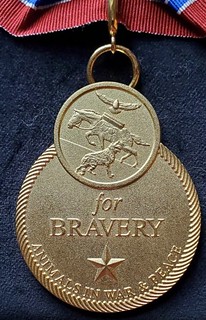
I asked about the medal maker and Robin Hutton replied, "The medal designer is Cleave & Company in London, England. They are the same medal maker for the PDSA Dickin Medal, and are the monarch's medal maker." -Editor
To watch a video of the ceremony, see:
Full Animals in War & Peace Medal Ceremony 2024 at U.S. Capitol
(https://www.youtube.com/watch?v=5V2Rdo_Dkro&t=27s)
To read the complete House Resolution, see:
H.Res.1054 - Recognizing the roles and contributions of military animals and their valiant human handlers for bravery in both war and peace, and acknowledging the importance of creating a process for honoring their valor and meritorious achievements.
(https://www.congress.gov/bill/118th-congress/house-resolution/1054/text)
For more information on Animals in War & Peace, see:
https://animalsinwarandpeace.org.
CRANE MUSEUM PAUSES LOCATION SEARCH
Changes in security on the company campus led to the closure the Crane Museum of Papermaking. After searching two years for a suitable alternate location, the museum is shifting to a pop-up model for the time being. -Editor
The Crane Museum of Papermaking has indefinitely paused its search for a permanent location and shifted its focus to a pop-up museum model.
The nonprofit organization searched for a location for two years but was unable to find one it liked. However, a successful pop-up museum last summer at Arrowhead got its leaders rethinking its operations.
It is currently unclear if it will reignite the search in the future, but at the moment, the museum's Director Jenna Ware is focusing on the summer season, educational programming, community events, and collaborating with other organizations in the area.
When Herman Melville's Arrowhead invited the Crane Museum to have a pop-up, Ware jumped at the opportunity because it had not had a long-standing display in a long time.
The Berkshire County Historical Society, which runs the Arrowhead museum, was very welcoming and allowed them to become available to the public quickly, Ware said.
The Crane Museum closed in the spring 2022 when the company, which makes paper currency including for the United States, upgraded its security operations.
The museum was located at 32 Pioneer St. in an ivy-covered stone structure dating from 1844 and listed on the National Register of Historic Places. It was the rag room for the first Crane paper mills and hosted exhibits on papermaking and the history of Crane & Co. and the Crane family, and had an activity area for learning how to make paper.
But as Crane grew, so did its campus, and getting to the small museum of papermaking meant driving through the industrial operations, Crane Currency's Global Marketing Director Tod Niedeck said during a previous meeting.
The need to keep the materials secure means the adjusted security parameters are no longer allowing for visitors on the property.
This summer the museum hopes to hold multiple pop-ups at more locations throughout Berkshire County.
Depending on the location and host organization, the Crane Museum may be able to curate the pop-up to the history of that organization and space.
Herman Melville had visited the mills at Crane and wrote a story about the visit, and bought his paper at Crane to write his books, but Arrowhead didn't have tactile material to display, only documented evidence, said Ware.
Found via News & Notes from the Society of Paper Money Collectors (Volume IX, Number 39, March 12, 2024) -Editor
To read the complete article, see:
Crane Museum Pauses Search for Permanent Location Indefinitely
(https://www.iberkshires.com/story/74671/Crane-Museum-Pauses-Search-for-Permanent-Location-Indefinitely.html)
LOOSE CHANGE: MARCH 17, 2024
Here are some additional items in the media this week that may be of interest. -Editor
France's new circulating Euro coins will feature female national icons. -Editor
France is redesigning its 10, 20 and 50 euro cent coins to honour women who have marked the country's history. The faces of national icons Simone Veil, Josephine Baker and Marie Curie will appear on coins set to go into circulation from the middle of 2024.
The new coins were designed by the French mint's chief engraver Joaquin Jimenez and feature the "three exceptional women".
Their profiles face in the same direction as "The Sower", the stylised female figure representing liberty that has been seen on French coins for the last 120 years.
The French side of the one and two cent coins, which feature oak and olive branches within a hexagon, was last redesigned for the 20th anniversary of the euro in 2022.
Great choices. Baker was born into poverty in St. Louis and went on to become a celebrated French dancer, singer and actress. She spoke at the 1963 March on Washington at the side of Martin Luther King Jr. "I have walked into the palaces of kings and queens, and into the houses of presidents and much more. But I could not walk into a hotel in America and get a cup of coffee, and that made me mad."
For another numismatic connection, Baker was awarded a number of medals in her long career. What were some of them, and where are those medals today? -Editor
To read the complete article, see:
Veil, Baker and Curie: acclaimed women to appear on new French coins
(https://www.rfi.fr/en/france/20240310-veil-baker-and-curie-acclaimed-women-to-appear-on-new-french-coins)
Medals given to referee Ken Aston following the 1970 World Cup and 1972 Independence Cup are coming up for sale. -Editor
TWO rare medals presented to the English referee who invented yellow and red cards are going under the hammer.
Ken Aston's family are auctioning the items which were given to the man credited with creating many of the rules we see in football today.
They are expected to fetch thousands when they go on sale at an auction in Rayleigh, Essex next month.
One of the medals - which is 21 carat gold - was handed to Aston after the 1970 World Cup.
Aston, who died aged 86 in 2001, was in charge of the referees for the 1970 tournament which was the first time Aston's idea of yellow and red cards were trialled.
The second item is a rare gold coin handed to Aston after the 1972 Independence Cup.
To read the complete article, see:
Rare footy medals belonging to ref who invented yellow and red cards to go under the hammer
(https://www.gbnews.com/sport/rare-footy-medals-ref-to-go-under-hammer)
A New York Times article reviews the Lindbergh Baby kidnapping and mentions the ransom notes. Have any been identified in collector hands? -Editor
The investigation, led by the New Jersey State Police and splashed across front pages worldwide, raged on until September 1934, when a $10 gold certificate from the ransom payment was used to buy gasoline in New York.
Investigators traced the car at the gas station to Hauptmann and later discovered $13,760 in ransom bills in his garage — money he said he'd been asked to hold for a man who died in Germany before the trial.
To read the complete article, see:
The Lindbergh Baby Kidnapping: A Grisly Theory and a Renewed Debate
(https://www.nytimes.com/2024/03/05/nyregion/charles-lindbergh-baby.html)
Dick Hanscom passed along this article about a new shipwreck find. Thanks. -Editor
A British warship has been identified off the Florida coast nearly three centuries after it sank while on patrol in the waters of what is now Dry Tortugas National Park, officials said. HMS Tyger went down with hundreds of sailors on board and the surviving crew were marooned on an uninhabited island for more than two months before making a dramatic escape on makeshift boats.
The shipwreck was initially located in 1993 off of Key West, but new research by archeologists has confirmed definitive evidence that the wreck is indeed the 50-gun frigate HMS Tyger, the National Park Service said on Thursday.
The ship sank on Jan. 13, 1742, after it ran aground on the reefs of the Dry Tortugas during the Anglo-Spanish War, a nine-year conflict between Britain and Spain, officials said. Old logbooks described how the crew "lightened her forward" — presumably by offloading heavy equipment — after initially running aground, briefly refloating the vessel and then sinking.
To read the complete article, see:
Warship identified off Florida coast 3 centuries after it sank
(https://www.msn.com/en-us/news/us/warship-identified-off-florida-coast-3-centuries-after-it-sank/ar-BB1jXxF4)


